The Caribbean region is an archipelago of islands located in the western part of the North Atlantic Ocean. The region boasts a stunning diversity of bird species, with some 564 species recorded in total.
Caribbean birds are a fascinating and unique aspect of the region’s natural heritage, with many species found nowhere else in the world.
Whether you’re an avid bird-watcher or just a casual observer, there are numerous opportunities to spot some of these colorful and charismatic creatures throughout the Caribbean islands.
From tiny hummingbirds and delicate songbirds to majestic raptors and water-loving shorebirds, there is a bird species to suit every birding interest.
This article will provide a comprehensive list of some of the most notable and iconic bird species found throughout the Caribbean.
1. Belted Kingfisher
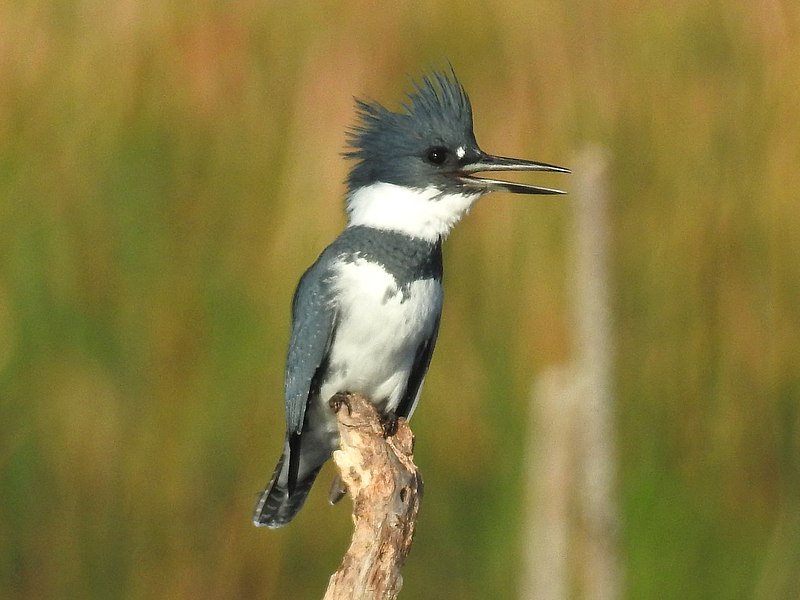
The belted kingfisher is a large, eye-catching bird native to North America. It belongs to the family Alcedinidae and has been divided into three subfamilies by recent research.
The species was first described in 1758 by Carl Linnaeus in his Systema Naturae.
This water Kingfisher stands out for its size as well as its striking plumage; males are bright blue on top with white below and females have rusty brown backs and wings with a thick black breast band across their chest.
They also possess an impressive call which can be heard from quite far away.
Belted kingfishers feed mainly on small fish but will sometimes also eat crustaceans, insects or even amphibians if they come across them while hunting around rivers or streams.
All in all, this is truly one remarkable bird that deserves our admiration.Scientific classification:
| Kingdom | Animalia |
| Phylum | Chordata |
| Class | Aves |
| Order | Coraciiformes |
| Family | Alcedinidae |
| Subfamily | Cerylinae |
| Genus | Megaceryle |
| Species | M. alcyon |
Also Featured In: Most Popular Bird Species in North America, Birds That Live in Colorado
2. Killdeer
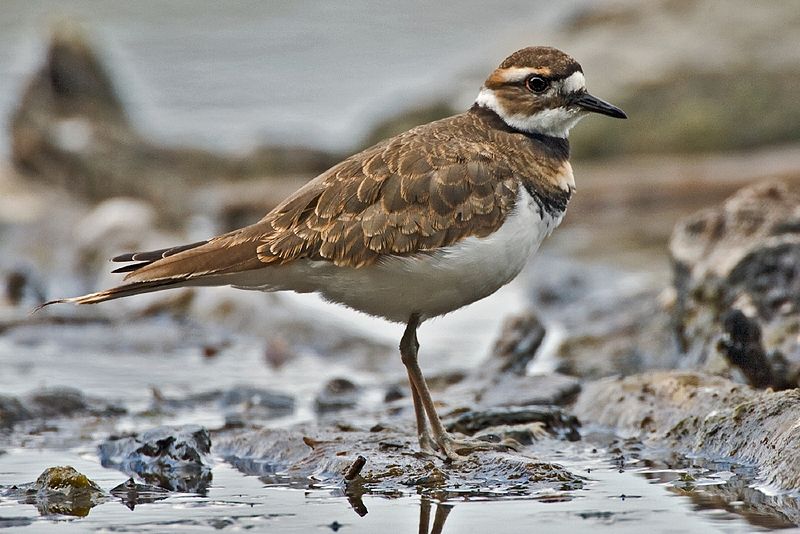
The Killdeer bird is a large plover found in the Americas. It has an unmistakable call which gives it its name, and boasts striking upperparts of brown with rufous fringes.
Its head features patches of white and black, while two distinctive bands adorn its neck – one black above, and one chestnut below.
The undersides are mostly white or pale buff-brown; their wings feature bright orange stripes when they take flight.
During breeding season males perform elaborate courtship rituals to attract females into establishing a pair bond; they also defend territories fiercely against other birds that encroach on them during this time.
In winter months some killdeers migrate southwards but many stay put throughout the cold weather too.
All in all these beautiful creatures provide us with quite a sight indeed.Scientific classification:
| Kingdom | Animalia |
| Phylum | Chordata |
| Class | Aves |
| Order | Charadriiformes |
| Family | Charadriidae |
| Genus | Charadrius |
| Species | C. vociferus |
Also Featured In: Birds that Live in San Francisco Bay Area, Wetlands Birds You Should Know
3. Sanderling
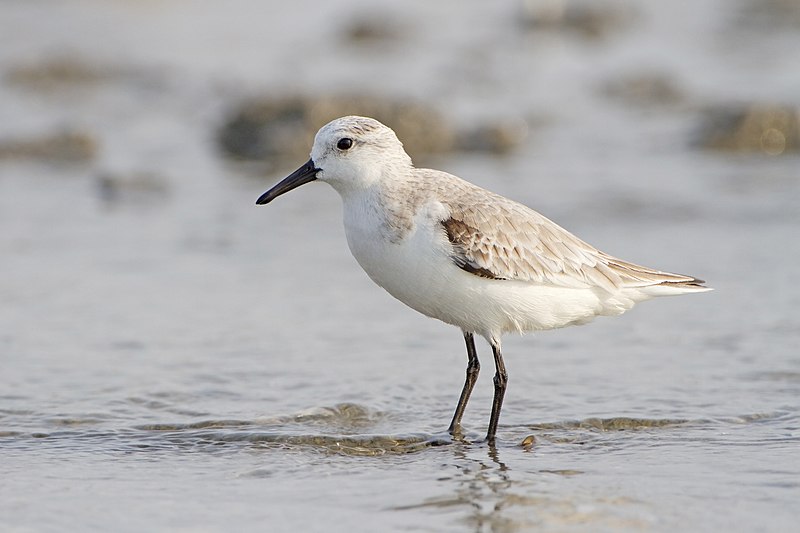
The Sanderling is a small wading bird that can be found in the Arctic region. Its name comes from Old English, meaning “sand-ploughman”. It has grey feathers and light legs which give it its distinct white coloration.
During summer breeding months, they are known to travel great distances – some wintering as far south as South America or Southern Africa. They typically feed on crustaceans such as shrimp and mollusks along coastal shores.
The Sanderling is an important species to watch out for because of their long migratory patterns and sensitivity to environmental change; if there’s trouble with this species then other birds may also be affected.Scientific classification:
| Kingdom | Animalia |
| Phylum | Chordata |
| Class | Aves |
| Order | Charadriiformes |
| Family | Scolopacidae |
| Genus | Calidris |
| Species | C. alba |
Also Featured In: Top Birds Found in Mexico, Galapagos Birds You Should Know
4. Magnificent Frigatebird
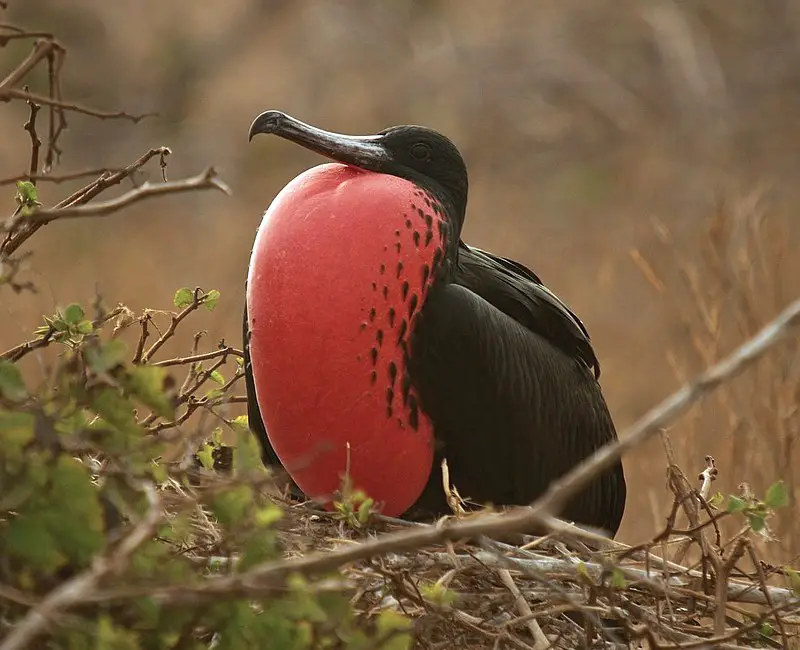
The Magnificent Frigatebird is the largest species of frigatebird, measuring between 89 and 114 cm in length and having a wingspan of 7-8 ft.
It can be found over tropical waters off America from northern Mexico to Peru on the Pacific coast, as well as Florida down south.
Its diet consists mainly of fish they take from other seabirds or snatch directly from the ocean surface while flying low above it.
They also feed on crustaceans and squid when available too.
This impressive bird has an unmistakable silhouette with its long pointed wings, forked tail feathers and male’s red gular pouch which inflates during courtship displays.Scientific classification:
| Kingdom | Animalia |
| Phylum | Chordata |
| Class | Aves |
| Order | Suliformes |
| Family | Fregatidae |
| Genus | Fregata |
| Species | F. magnificens |
Also Featured In: Birds that Live in the Ocean , Most Common Birds in South America Birds
5. Brown Booby
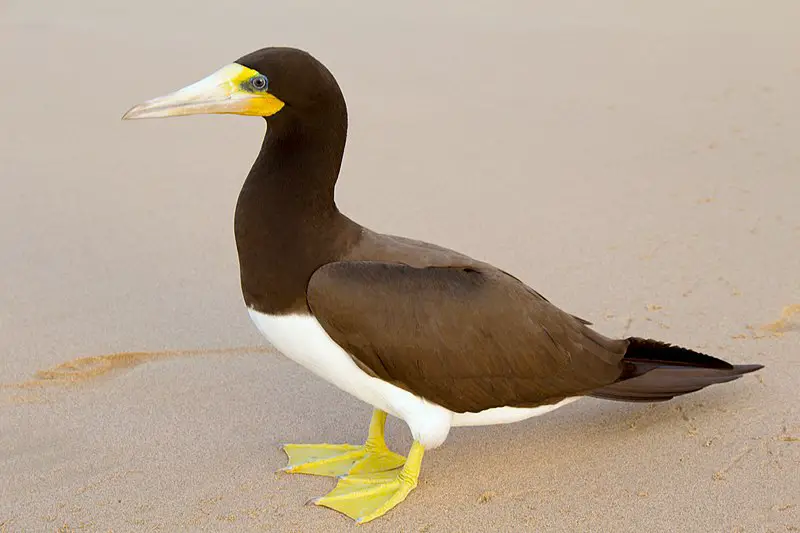
The Brown Booby is a large, seabird from the booby family Sulidae. It has a pantropical range and can be found in many areas of the world.
This bird lives in flocks and forages by plunging into shallow waters to catch small fish that are driven near the surface by predators or storms.
The brown booby is known for its short wings which make it highly maneuverable when hunting; this allows it to pursue prey quickly with sudden turns and dives.
Its diet also includes squid, crustaceans, eggs of other birds, as well as scraps from boats or ships they may come across while flying around coastlines.
They sometimes rest on floating objects during their long flights over open water between islands or continents.Scientific classification:
| Kingdom | Animalia |
| Phylum | Chordata |
| Class | Aves |
| Order | Suliformes |
| Family | Sulidae |
| Genus | Sula |
| Species | S. leucogaster |
Also Featured In: Egyptian Birds, Birds that You’ll Find in Puerto Rico
6. Tropical Mockingbird
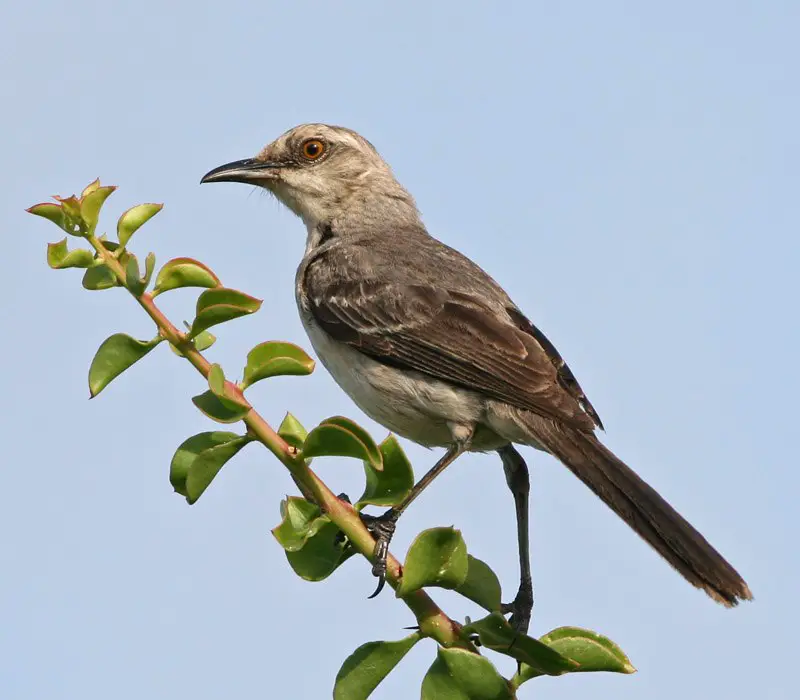
The Tropical mockingbird is a species of bird found throughout Central America and the Caribbean. It has been classified as a resident breeding bird, with its range stretching from southern Mexico to northern and eastern South America.
This species is closely related to the Northern Mockingbird, forming what is known as a superspecies between them both.
The Tropical mockingbird can be recognized by its grey-brown coloration on top, blending into white underparts which are highlighted by black spots along their throat and wings.
They have long legs for perching in trees or shrubs while searching for prey such as insects before singing out melodic songs during territorial disputes with other birds in the area.
Sadly, one subspecies -the San Cristobal Mockingbird – has been listed as critically endangered due to habitat destruction caused by human activities including logging within their natural environment.Scientific classification:
| Kingdom | Animalia |
| Phylum | Chordata |
| Class | Aves |
| Order | Passeriformes |
| Family | Mimidae |
| Genus | Mimus |
| Species | M. gilvus |
Also Featured In: Common Birds in Colombia, Birds that Live in Guyana
7. Smooth-Billed Ani
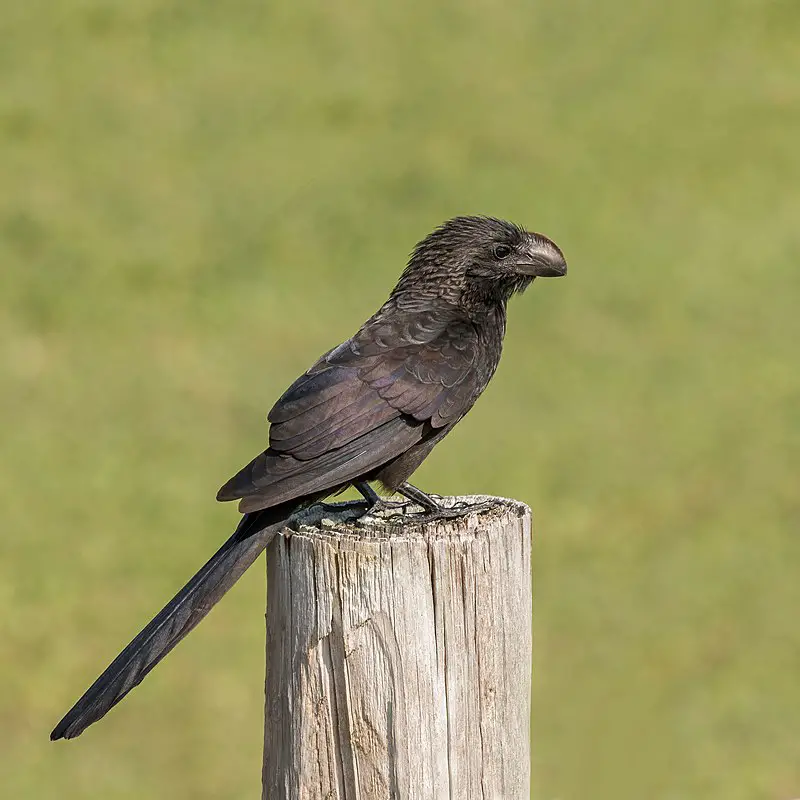
The Smooth-billed Ani is a species of bird in the cuckoo family, native to regions spanning from southern Florida and the Caribbean down through Central America, South America, and parts of Argentina.
They have even been introduced to Galapagos around 1960s where they may be impacting local wildlife due to their aggressive nature.
As its name suggests, these birds have smooth bills which are adapted for feeding on hard fruits or other items such as insects and lizards that it finds while scavenging around trees or ground level vegetation.
They usually form small flocks when out searching for food with males being slightly larger than females.
Overall this adaptable species is found in many habitats across its broad range but does best at low elevation open areas near water sources like marshes or swamps making them easier targets for human disturbance as well.Scientific classification:
| Kingdom | Animalia |
| Phylum | Chordata |
| Class | Aves |
| Order | Cuculiformes |
| Family | Cuculidae |
| Genus | Crotophaga |
| Species | C. ani |
Also Featured In: British Virgin Islands Birds You Need to See, Green Birds Commonly Found in Florida
8. American Flamingo
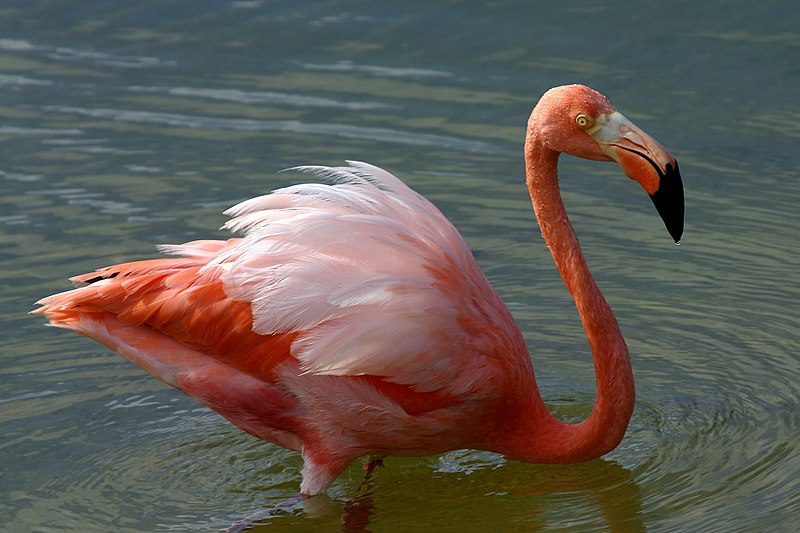
The American flamingo is a large species of bird found in the Neotropics. It has bright pink feathers and long legs, making it easily distinguishable from other species of flamingos.
The diet consists mostly of shrimp and small fish but they are also known to eat algae, aquatic insects, mollusks, crustaceans and seeds.
They live around coastal lagoons or salt ponds in colonies with thousands of birds nesting together on mud flats.
Flamingos build nests out of sticks that sit atop their feet as they wade through shallow waters looking for food during low tide periods when these areas become more accessible for feeding purposes.
These birds have an interesting courtship ritual involving neck stretching which looks like a dance to attract mates before breeding season begins in May-June each year leading to chicks hatching during July-August time periodScientific classification:
| Kingdom | Animalia |
| Phylum | Chordata |
| Class | Aves |
| Order | Phoenicopteriformes |
| Family | Phoenicopteridae |
| Genus | Phoenicopterus |
| Species | P. ruber |
Also Featured In: Birds You’ll Find in Zoo, Birds that Make Mud Nests
9. Glossy Ibis
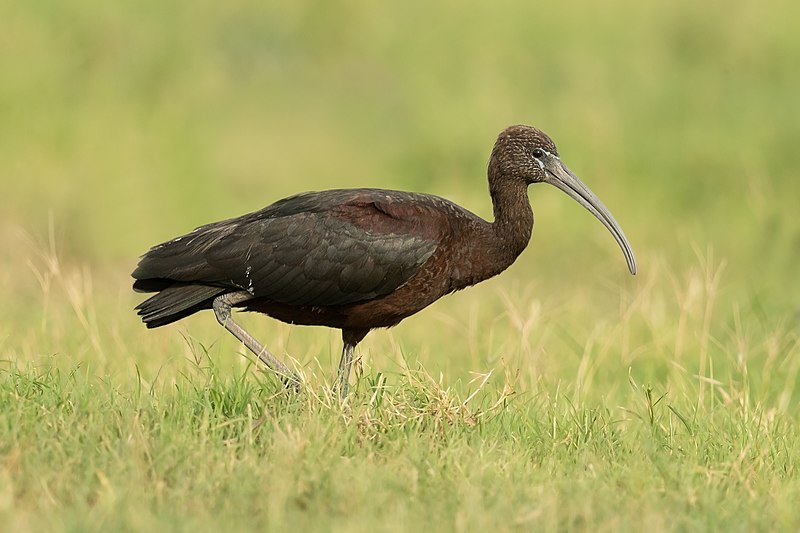
The Glossy Ibis is a water bird that belongs to the family Threskiornithidae. It has an unique bill in the shape of a sickle, which gave it its scientific name – Plegadis falcinellus.
It can be found widely across Europe, Asia and Africa, with scattered nesting sites in warm regions.
Its feathers are black-brown on top and chestnut brown from below; their wings have glossy greenish-purple sheen when seen from afar.
They mainly feed on small insects like grasshoppers, spiders or earthworms as well as crustaceans or amphibians caught while wading through shallow waters.
During breeding season they also consume plant material such as rice grains or corn kernels provided by humans near habitat areas where they nest.Scientific classification:
| Kingdom | Animalia |
| Phylum | Chordata |
| Class | Aves |
| Order | Pelecaniformes |
| Family | Threskiornithidae |
| Genus | Plegadis |
| Species | P. falcinellus |
Also Featured In: Uganda Birds Species, Turkey Birds You Should Know
10. Fulvous Whistling Duck
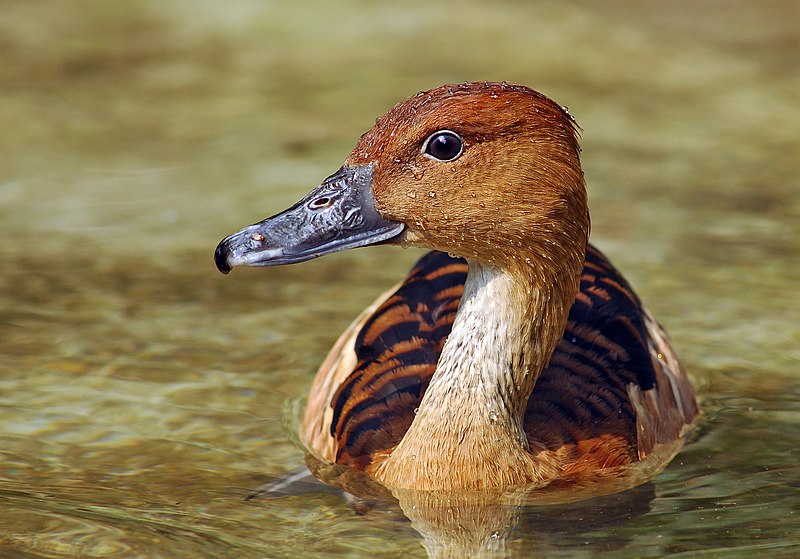
The Fulvous Whistling Duck is a species of whistling duck that can be found in tropical regions around the world.
It has a reddish-brown plumage, long legs and grey bill with distinctive white band across it.
This bird usually lives near water sources like wetlands or marshes where they feed on seeds, plants and small insects which make up their diet.
The male ducks are known to produce loud calls at night during breeding season as part of courtship rituals for attracting female partners.
They also congregate together in flocks when migrating from one area to another making them visible even from far distances.
Overall these amazing birds add beauty and joy to any natural environment.Scientific classification:
| Kingdom | Animalia |
| Phylum | Chordata |
| Class | Aves |
| Order | Anseriformes |
| Family | Anatidae |
| Genus | Dendrocygna |
| Species | D. bicolor |
Also Featured In: Birds of Argentina, Brown Birds of Florida
11. Great Blue Heron

The Great Blue Heron is a majestic wading bird found in many parts of North America, Central America, the Caribbean and even as far away as the Galapagos Islands.
It has an impressive wingspan which can reach up to six feet wide. Its feathers are mainly bluish-gray with brownish streaks on both its neck and chest while its head displays white plumes.
The adult herons can also be identified by their yellow bill and legs.
They live near bodies of water such as lakes, marshes or rivers where they feed on fish using a spear like motion with their sharp bills.
An all-white population exists only in south Florida and the Florida Keys making it quite unique.Scientific classification:
| Kingdom | Animalia |
| Phylum | Chordata |
| Class | Aves |
| Order | Pelecaniformes |
| Family | Ardeidae |
| Genus | Ardea |
| Species | A. herodias |
Also Featured In: Common Birds in Canada, Birds Commonly Found in New York
12. Sandwich Tern
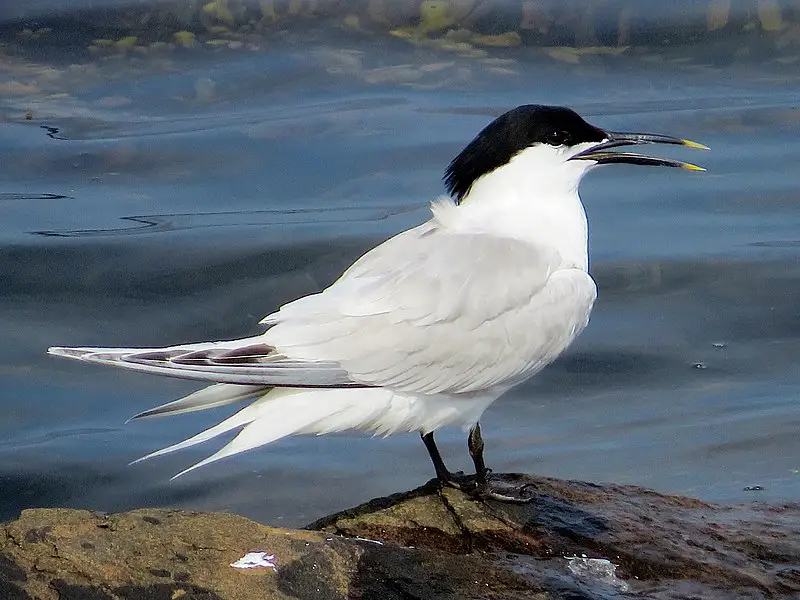
The Sandwich Tern is a medium-sized tern species belonging to the family Laridae. It has close relationships with four other crested terns, and is known to interbreed with the lesser crested.
These birds are distributed throughout Europe and as far east as Caspian Sea in summer, while they migrate south during winter season up to South Africa and India.
They have long wings which help them fly over vast distances effortlessly.
The plumage of these birds consists mainly of greyish tones on its body combined with white head and neck area; whereas it also sports an orange beak along black markings near their eyes – giving them a distinct look from other related species.Scientific classification:
| Kingdom | Animalia |
| Phylum | Chordata |
| Class | Aves |
| Order | Charadriiformes |
| Family | Laridae |
| Genus | Thalasseus |
| Species | T. sandvicensis |
Also Featured In: Birds of Netherlands, Birds of Farne Islands
13. Red Knot
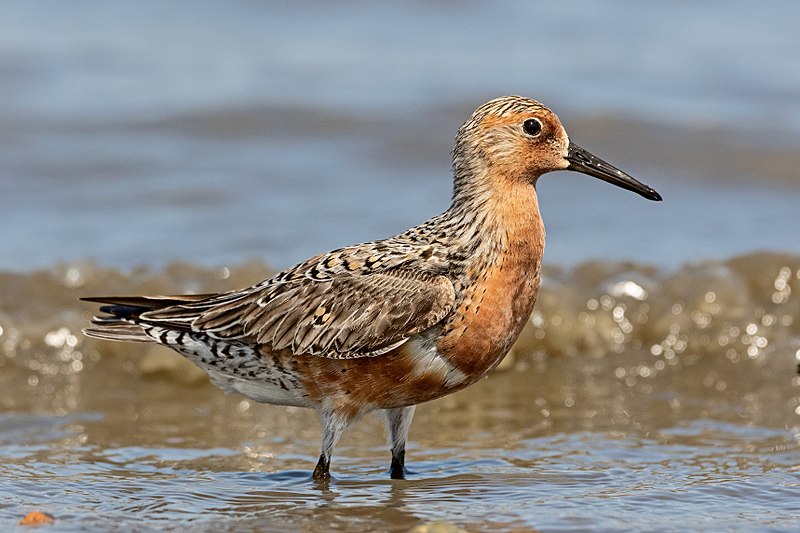
The Red Knot is a medium-sized shorebird that inhabits tundra and Arctic Cordillera in the far north of Canada, Europe and Russia.
It belongs to the Calidris sandpipers family, being one of its largest members second only to the Great Knot.
This species has six subspecies recognized worldwide. During breeding season their diet consists mainly on arthropods and larvae; however they may also feed on other items such as molluscs or crustaceans according to availability during migration periods.
They are known for their long migratory journeys which can last up to 20 000 kilometers per year – from wintering grounds in South America all the way through North American coasts until reaching summer nesting sites across Northern Eurasia.Scientific classification:
| Kingdom | Animalia |
| Phylum | Chordata |
| Class | Aves |
| Order | Charadriiformes |
| Family | Scolopacidae |
| Genus | Calidris |
| Species | C. canutus |
Also Featured In: Flocks Birds around Us, Birds That Live around Grand Turk Island
14. Ruddy Turnstone
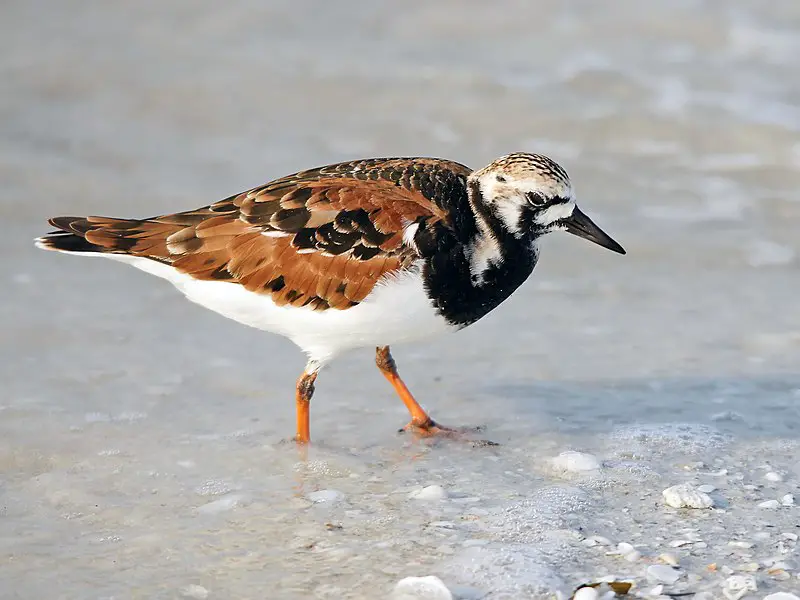
The Ruddy Turnstone is a small wading bird, belonging to the sandpiper family Scolopacidae. It has an attractive reddish-brown coloration and black patches on its back and wings.
This species breeds in northern parts of Eurasia and North America during summertime before migrating southwards in winter season to coastlines all over the world.
The Ruddy Turnstone feeds mainly on insects, mollusks, crustaceans, worms and some plant material such as seeds or berries which it finds by probing into mudflats with its bill.
It also uses stones for turning them when searching for food under rocks or pebbles along shorelines where they can often be seen darting around looking very busy.Scientific classification:
| Kingdom | Animalia |
| Phylum | Chordata |
| Class | Aves |
| Order | Charadriiformes |
| Family | Scolopacidae |
| Genus | Arenaria |
| Species | A. interpres |
Also Featured In: Hawaii Big Island Birds You Should Know, Birds that Live in Mississippi
15. Greater Antillean Grackle
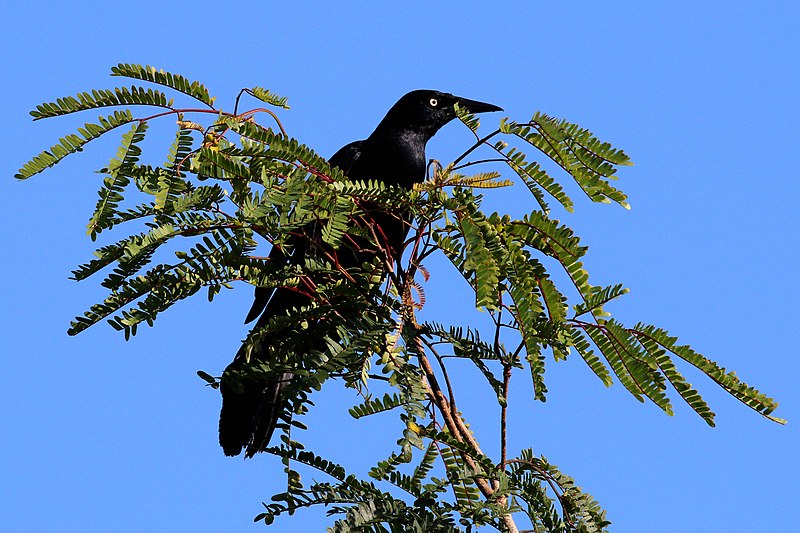
The Greater Antillean grackle is a large, sociable bird found in the Caribbean. It inhabits heavily populated areas and its call has been described as “kling-kling” or “chinchilin” in the Dominican Republic, “ching ching” in the Cayman Islands and ‘Chango’ by Puerto Rico locals.
They are mostly black with green iridescence on their upperparts, wings and tail feathers.
These birds feed mainly of insects but also consume fruits from trees like guava and mangoes.
Their diet supplements can include breadcrumbs from picnic tables that they often frequent near human dwellings for food scraps left behind by humans which allow them to survive even during dry seasons when other sources of food become scarce.Scientific classification:
| Kingdom | Animalia |
| Phylum | Chordata |
| Class | Aves |
| Order | Passeriformes |
| Family | Icteridae |
| Genus | Quiscalus |
| Species | Q. niger |
Also Featured In: Birds of Haiti, Beautiful Birds Found in Grand Cayman
16. Hispaniolan Woodpecker
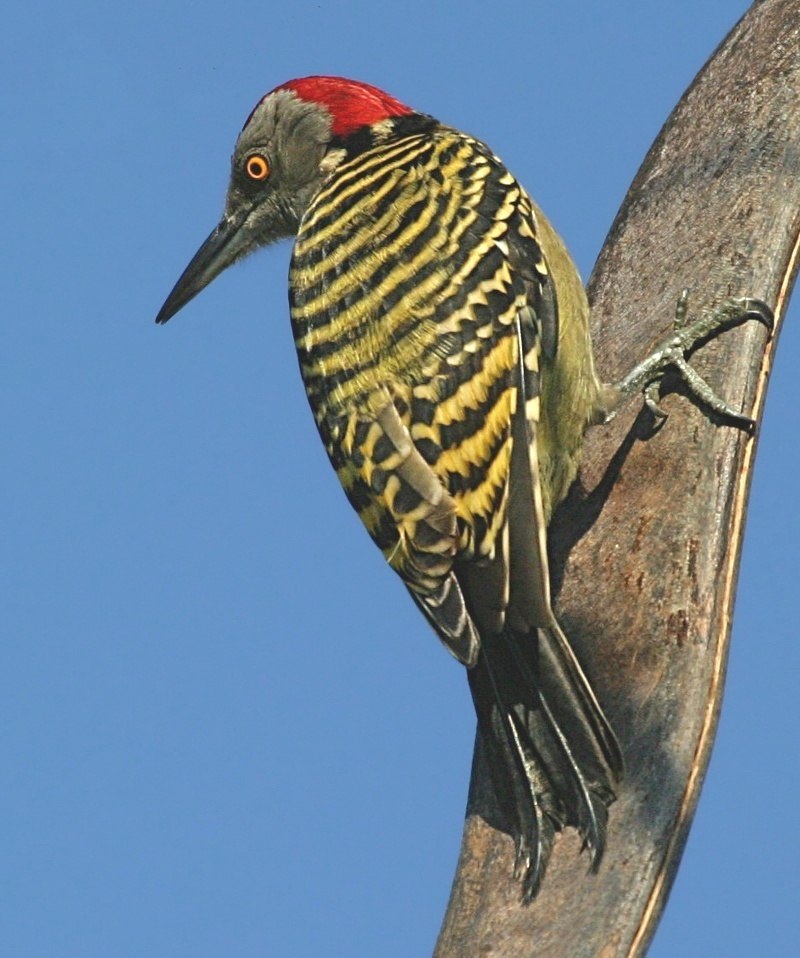
The Hispaniolan woodpecker is a beautiful bird endemic to the Caribbean island of Hispaniola. It has gold and black barred feathers, with males having an added red crown and nape.
The male also has a longer beak than the female, with its upper neck being white in coloration.
This medium-sized woodpecker grows up to 22 – 28 cm long and can often be seen pecking away at tree bark or logs while looking for food such as insects larvae, spiders, lizards and other small animals.
They mainly inhabit broadleaf forests but can also sometimes be found near plantations or secondary growth areas too.
With their distinctive calls heard throughout these habitats during mating season it’s easy to spot them amongst any greenery that you may come across on this lovely island.Scientific classification:
| Kingdom | Animalia |
| Phylum | Chordata |
| Class | Aves |
| Order | Piciformes |
| Family | Picidae |
| Genus | Melanerpes |
| Species | M. striatus |
Also Featured In: Birds That You’ll Find in Hispaniola,
17. Antillean Euphonia
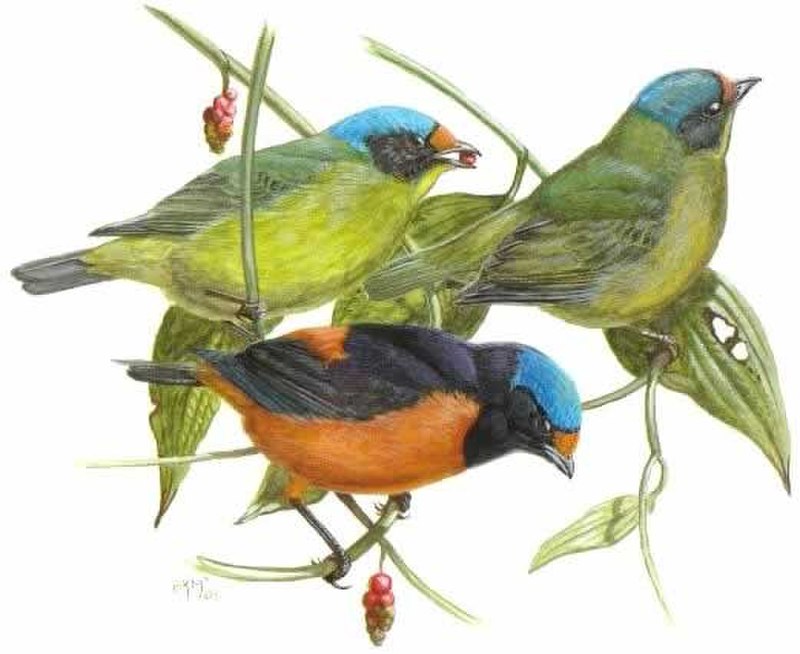
The Antillean euphonia is a colorful and beautiful bird species found across the Lesser Antilles, Hispaniola (Dominican Republic and Haiti) and Puerto Rico.
It belongs to Fringillidae family of finches. This small songbird has strong yellow feathers on its head with blue-green upperparts while they have bright orange breasts and bellies.
Their wings are blackish with white tips, giving them an attractive look when flying in flocks through woodlands or forest edges.
They inhabit subtropical or tropical dry forests as well as moist lowland forests including degraded former ones too.
The populations of this species are declining due to deforestation but still remain common throughout their range if habitats can be preserved for their long term future survival.Scientific classification:
| Kingdom | Animalia |
| Phylum | Chordata |
| Class | Aves |
| Order | Passeriformes |
| Family | Fringillidae |
| Subfamily | Euphoniinae |
| Genus | Chlorophonia |
| Species | C. musica |
Also Featured In: Martinique Island Birds You Should Know, Native Birds Of Guadeloupe Island
18. Black-Capped Petrel
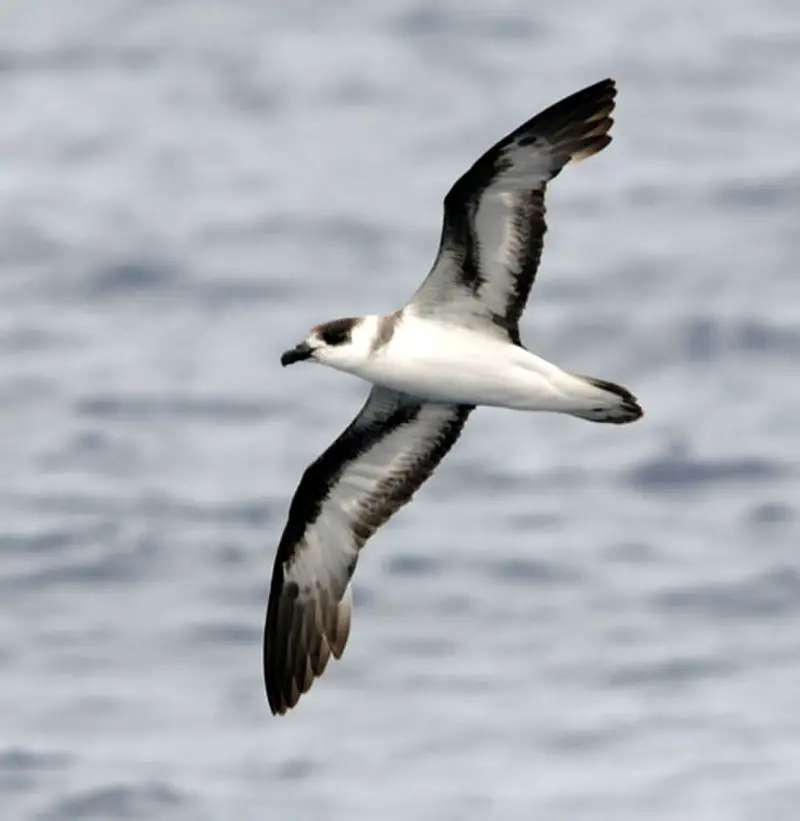
The Black-capped Petrel is a small seabird native to the West Indies. It has grey-brown back and wings, with a white nape and rump.
Its distinct feature is its black cap which extends to cover the eye in some individuals.
They have mainly white underparts apart from dark underwing markings as well.
These birds typically feed on crustaceans, fish eggs, squid or jellyfish plucked out of water while flying low over it with their relatively long wingspan aiding them in flight efficiency and speed.
Breeding season occurs around July-September during which they inhabit rocky cliff ledges near the shorelines for nesting purposes where they lay one egg at a time per nest.Scientific classification:
| Kingdom | Animalia |
| Phylum | Chordata |
| Class | Aves |
| Order | Procellariiformes |
| Family | Procellariidae |
| Genus | Pterodroma |
| Species | P. hasitata |
Also Featured In: Common Birds of Turks and Caicos Islands,
19. Tody
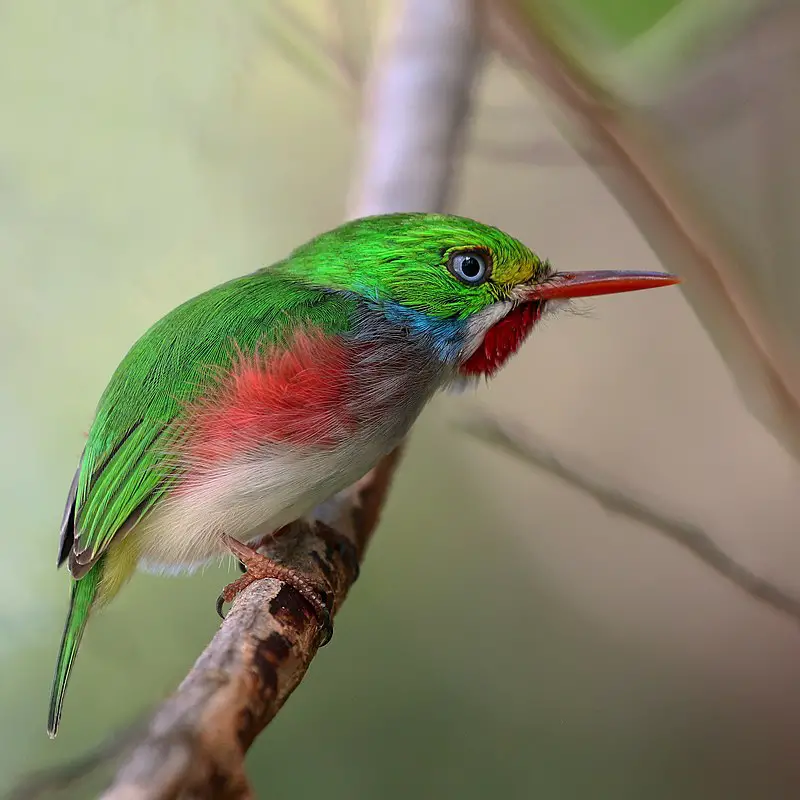
Tody birds are small yet stunningly beautiful Caribbean birds that belong to the Coraciiformes order, which also includes kingfishers, bee-eaters and rollers.
They make up the family Todidae with one living genus – Todus – and a fossilized genus called Palaeotodus.
The first classification of these birds was done by Mathurin Jacques Brisson in 1760 who placed them in their own distinct genus; they were originally part of Alcedo (the kingfisher).
These tiny beauties have bright green bodies with white bellies, black heads capped with red or orange feathers depending on species, short tails and yellow legs.
They live mainly in forests but will sometimes venture out into open meadows where they can be seen hunting insects like most other hummingbirds do.Scientific classification:
| Kingdom | Animalia |
| Phylum | Chordata |
| Class | Aves |
| Order | Coraciiformes |
| Family | Todidae Vigors, 1825 |
Also Featured In: Most Common Types of Birds Found in Cuba,
20. West Indian Whistling Duck
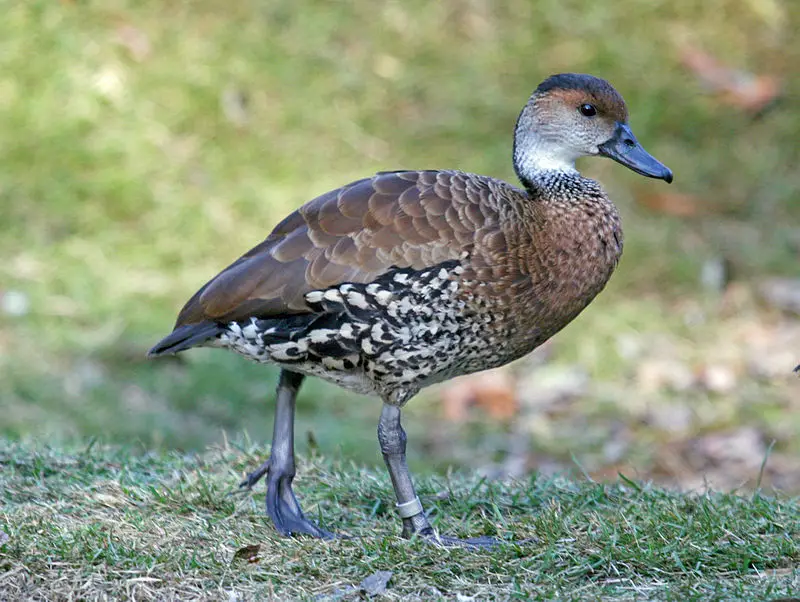
The West Indian whistling duck is a beautiful species of bird native to the Caribbean. This duck has an unmistakable call, as its name implies it can whistle.
It also has black bill and legs with grey-brown feathers that help camouflage it in its environment.
The primary breeding range of this species includes the Bahamas, Cuba, Cayman Islands, Antigua and Barbuda Jamaica, Hispaniola and Puerto Rico where they live mainly in shallow freshwater wetlands such as ponds or swamps.
Besides their distinctive whistles these birds are able to communicate through various other calls including grunts , honks and quacks.
They feed on aquatic plants but may occasionally eat small invertebrates like insects too.
Despite being hunted for food by humans these ducks still remain widespread throughout their habitats due to successful conservation efforts put into place over recent years making them a symbol of hope for many wildlife enthusiasts around the world today.Scientific classification:
| Kingdom | Animalia |
| Phylum | Chordata |
| Class | Aves |
| Order | Anseriformes |
| Family | Anatidae |
| Genus | Dendrocygna |
| Species | D. arborea |
Also Featured In: Native Birds Of Middle Caicos, Common Birds Found near North Caicos
21. Bananaquit
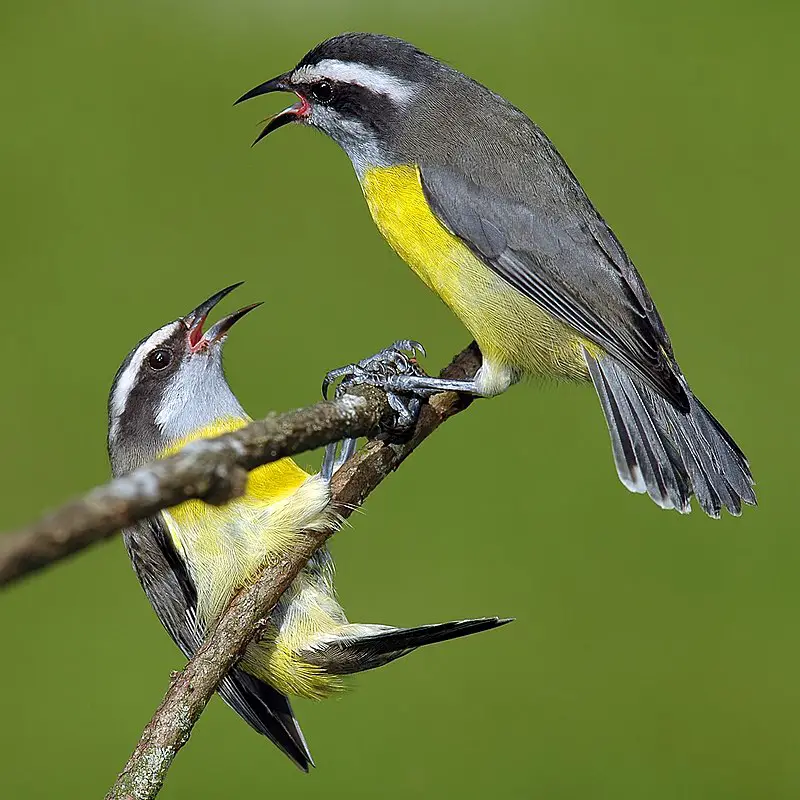
The Bananaquit, scientifically known as Coereba flaveola, is a small passerine bird belonging to the tanager family Thraupidae.
It was previously classified in either its own monotypic family or with other species such as buntings and New World sparrows (Emberizidae) or warblers (Parulidae).
This beautiful little bird has a yellow-green upper body, pale grey head and chestnut brown wings.
Its tail feathers are blackish while its belly is white with some faint streaks of olive green coloration.
The bananaquit can be found across Central America and the Caribbean islands where it feeds on fruits like bananas for which it gets its name from.Scientific classification:
| Kingdom | Animalia |
| Phylum | Chordata |
| Class | Aves |
| Order | Passeriformes |
| Family | Thraupidae |
| Genus | Coereba Vieillot, 1809 |
| Species | C. flaveola |
Also Featured In: Dominican Republic birds, Rainforest Birds You Should Know
22. Hooded Warbler
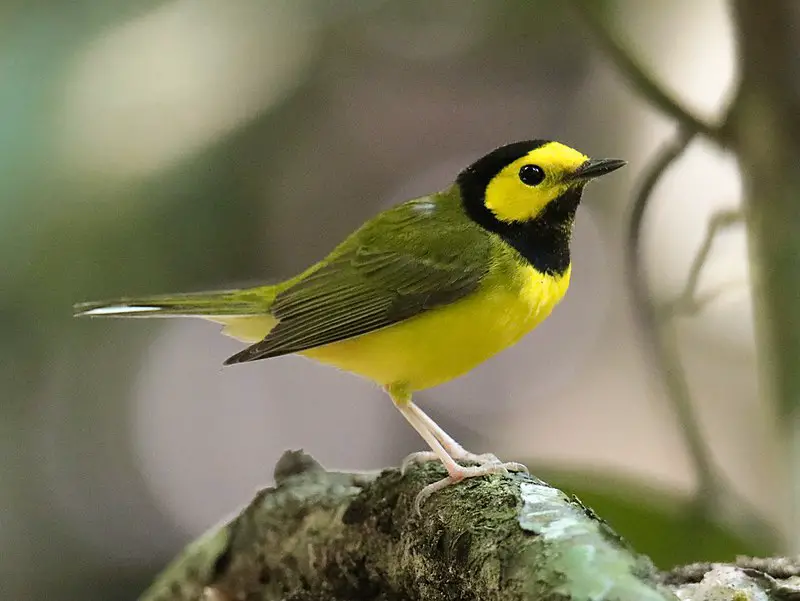
The Hooded Warbler is a species of New World warblers that breed in eastern North America and migrate to Central America and the West Indies for winter.
It has distinctive yellow, hood-like markings on its head which distinguish it from other similar looking birds.
Recent genetic research suggests that this bird was originally classified as Wilsonia citrina, making it one of the oldest known species discovered by scientists today.
The Hooded Warbler can be found near moist woodlands where they feed mainly on insects such as caterpillars and grasshoppers.
They have also been observed eating fruits including wild cherries during migration periods when food sources are scarce.
This unique little bird plays an important role in maintaining healthy ecosystems throughout their range; however climate change may pose serious threats to their survival if not addressed soon enough.Scientific classification:
| Kingdom | Animalia |
| Phylum | Chordata |
| Class | Aves |
| Order | Passeriformes |
| Family | Parulidae |
| Genus | Setophaga |
| Species | S. citrina |
Also Featured In: Georgia Birds, Yellow Birds You’ll Find in Minnesota
23. Royal Tern
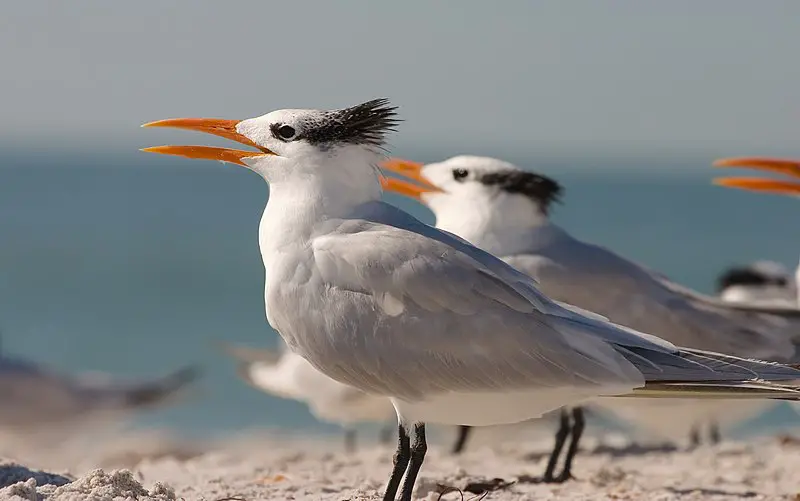
The Royal Tern is a beautiful seabird, endemic to the Americas. It has been spotted as far away as Europe on rare occasions though.
The species was first described by Georges-Louis Leclerc in 1781 from a specimen found in French Guiana and later illustrated with hand-coloured plates.
These birds have elaborate courtship displays that involve loud vocalizations and energetic aerial acrobatics.
They typically mate for life, nesting together near marshes or beaches each season close to their food source of fish and other small aquatic creatures. Their white plumage brightens up coastlines across America – they are truly majestic.Scientific classification:
| Kingdom | Animalia |
| Phylum | Chordata |
| Class | Aves |
| Order | Charadriiformes |
| Family | Laridae |
| Genus | Thalasseus |
| Species | T. maximus |
Also Featured In: Uruguay birds, Summer Birds that Live around Us
24. Yellow Oriole
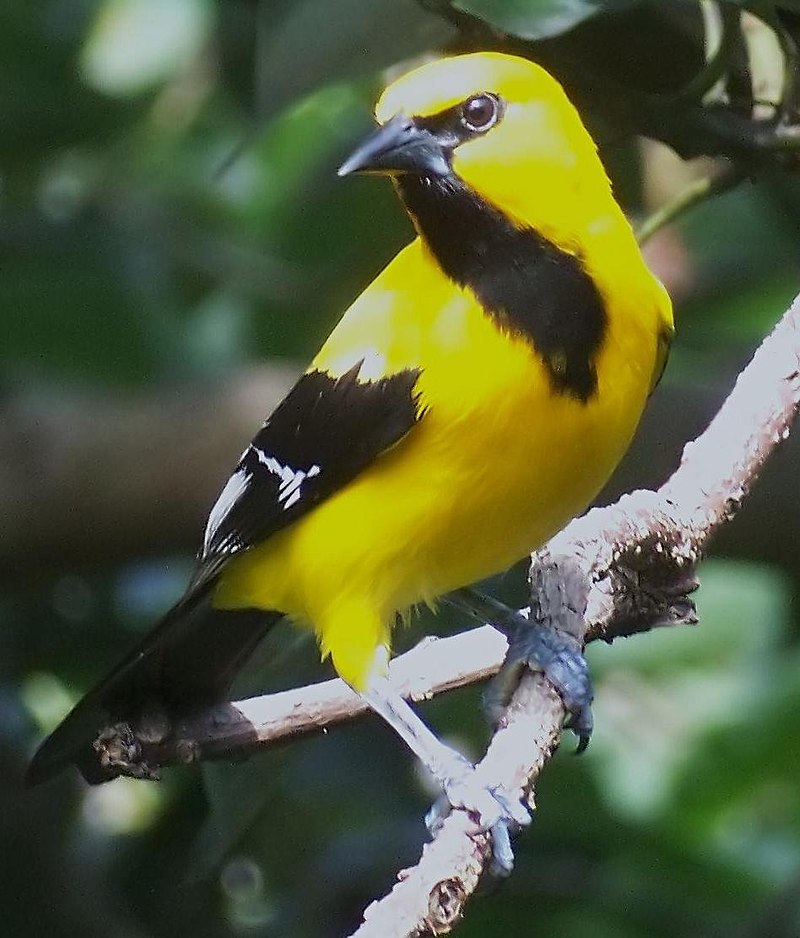
The Yellow Oriole is a beautiful passerine bird belonging to the Icteridae family. It has yellow feathers on its head, wings and back with black stripes running across them while it’s underparts are bright white in colour.
The adult male has an orange-yellow throat patch and females have grey throats.
They can be found breeding in northern South America where they inhabit dense woodland areas and open savanna habitats close to rivers or lakes.
Known as the Plantain Bird or Small Corn Bird by locals, these birds feed mainly on insects but will also consume fruits such as plantains and small corn grains for their diet. In Venezuela they’re known affectionately as ‘Gonzalito’.
A truly stunning species of wildlife worth keeping an eye out for when travelling through South America.Scientific classification:
| Kingdom | Animalia |
| Phylum | Chordata |
| Class | Aves |
| Order | Passeriformes |
| Family | Icteridae |
| Genus | Icterus |
| Species | I. nigrogularis |
Also Featured In: Trinidad and Tobago birds, Common Margarita Island Birds
25. White-Tailed Tropicbird
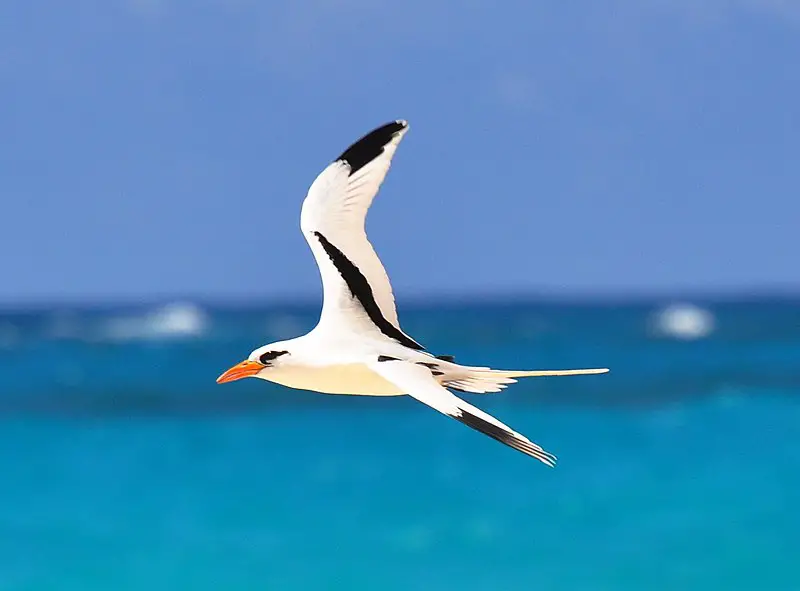
The White-tailed Tropicbird is a beautiful seabird that lives in the tropical waters of the Atlantic, Pacific, and Indian Oceans.
It is the smallest member of its order Phaethontiformes, measuring only 28 inches from head to tail.
Its wingspan can reach up to 45 inches wide. The bird has white plumage with black markings on its wings and tail feathers.
It also has an unmistakable long streamer which trails out behind them when they are in flight – a characteristic feature for all tropicbirds.
They nest mainly on remote islands throughout their range but have recently begun nesting on Little Tobago as well.
These birds feed primarily off flying fish or squid near the ocean’s surface during daylight hours before returning back home at nightfall.Scientific classification:
| Kingdom | Animalia |
| Phylum | Chordata |
| Class | Aves |
| Order | Phaethontiformes |
| Family | Phaethontidae |
| Genus | Phaethon |
| Species | P. lepturus |
Also Featured In: Mauritius birds, Birds of Kauai, Hawaii
26. Masked Booby
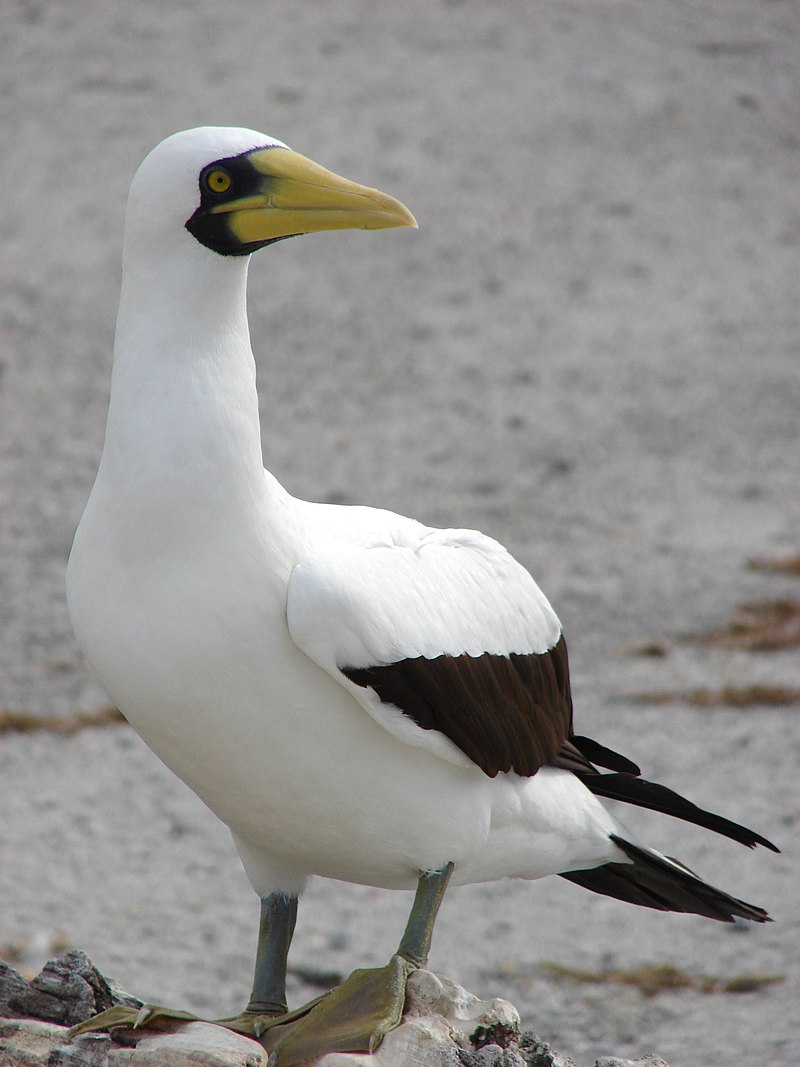
The Masked Booby is a large seabird belonging to the booby and gannet family. It was first described by French naturalist René-Primevère Lesson in 1831, making it one of six species of boobies within its genus Sula.
It has an impressive aerodynamic body shape with pale grey or white plumage on its head and neck, while the rest of its body is blackish brown.
Its wingspan can reach up to 1 metre wide. The bill is yellowish and pointed at the end, whilst they have bright blue skin around their eyes – this is why they are also known as ‘blue-faced’ boobies.
They use their strong wings for soaring over oceans in search of fish which makes them excellent fishers who feed mainly on flying fish near tropical waters but can occasionally be found off coasts in temperate regions too.Scientific classification:
| Kingdom | Animalia |
| Phylum | Chordata |
| Class | Aves |
| Order | Suliformes |
| Family | Sulidae |
| Genus | Sula |
| Species | S. dactylatra |
Also Featured In: White Birds Commonly Found in Hawaii, Most Common Oaxaca Birds
27. Spotted Sandpiper
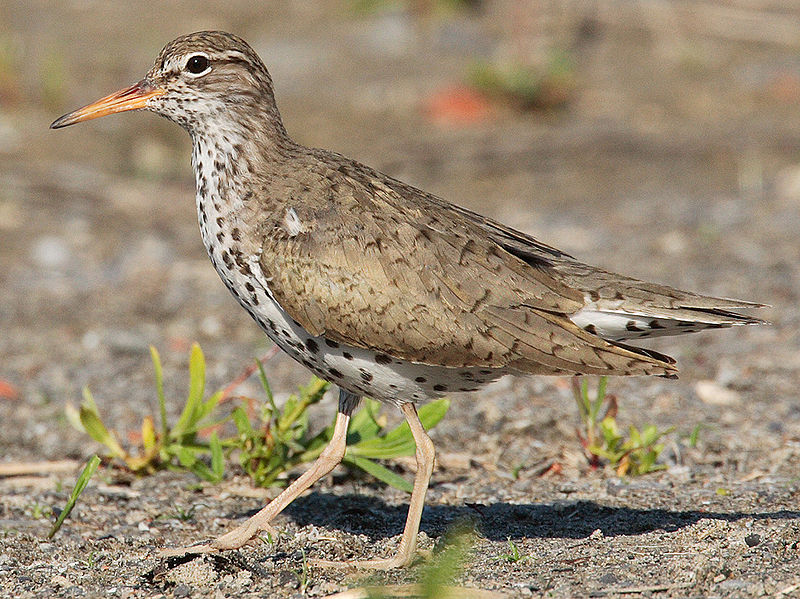
The Spotted sandpiper (Actitis macularius) is a small shorebird that can be found across North America and parts of South America.
It has an appealing spotted plumage, predominately brown in colour with white spots on the wings, tail feathers, head and neck.
The Common Sandpiper (A. hypoleucos) is its sister species which takes over geographically when the other moves away; they have been known to hybridize as well when strays settle down among breeders.
This bird was first described by Carl Linnaeus in 1766 in his twelfth edition of Systema Naturae as a migratory summer visitor to Europe but it now also occupies many habitats too like beaches, riversides and even grasslands during migration periods or for breeding season itself.
Its diet consists mainly of insects such as air-borne flies plus molluscs from shallow water areas – this makes them quite unique amongst waders.Scientific classification:
| Kingdom | Animalia |
| Phylum | Chordata |
| Class | Aves |
| Order | Charadriiformes |
| Family | Scolopacidae |
| Genus | Actitis |
| Species | A. macularius |
Also Featured In: Suriname birds, Birds in Calgary You’ll Love to See
28. Red-Footed Booby
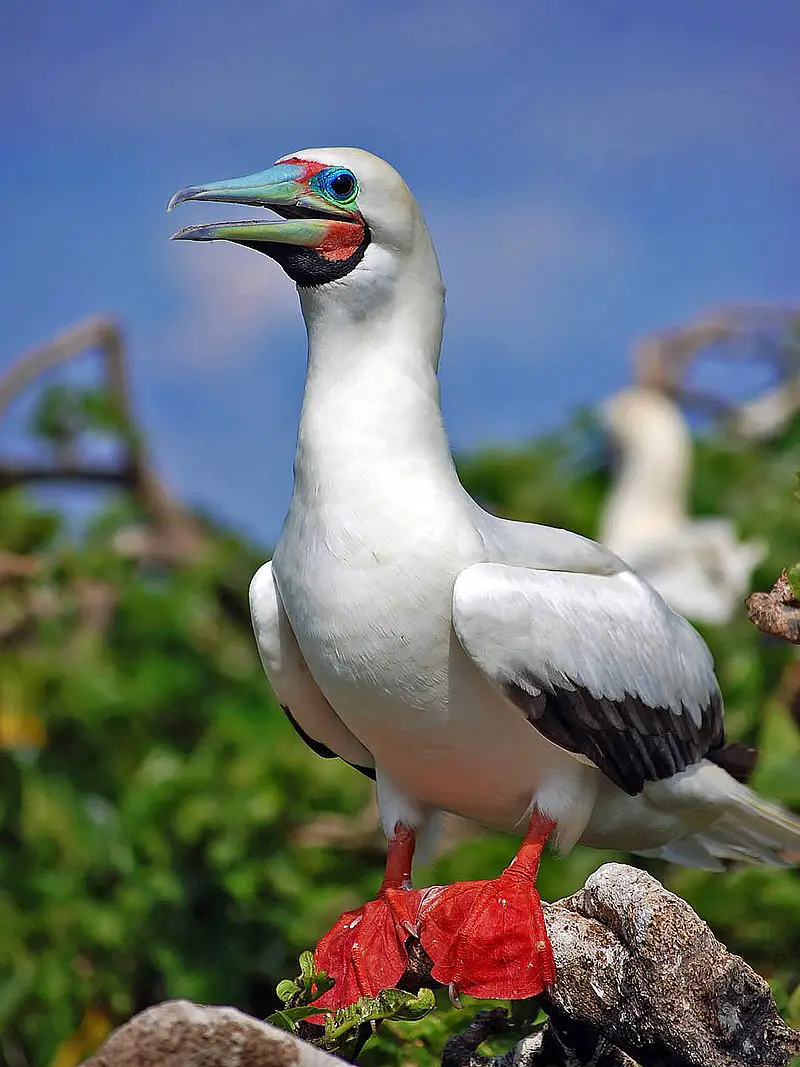
The Red-footed Booby is a large seabird of the Sulidae family, easily distinguished by its bright red feet. These birds are strong and agile fliers but can be clumsy in takeoffs and landings.
They live mostly in tropical areas and breed colonially on coastal islands all over the world.
The species faces few threats from either nature or humans, however their population has decreased slightly due to disturbances near breeding sites.
Despite this mild decline, they remain an incredibly common sight across many parts of the tropics – so much so that they have become symbolic with island life.Scientific classification:
| Kingdom | Animalia |
| Phylum | Chordata |
| Class | Aves |
| Order | Suliformes |
| Family | Sulidae |
| Genus | Sula |
| Species | S. sula |
Also Featured In: Cabo Verde birds, Most Common Oahu Birds
29. Audubon’s Shearwater
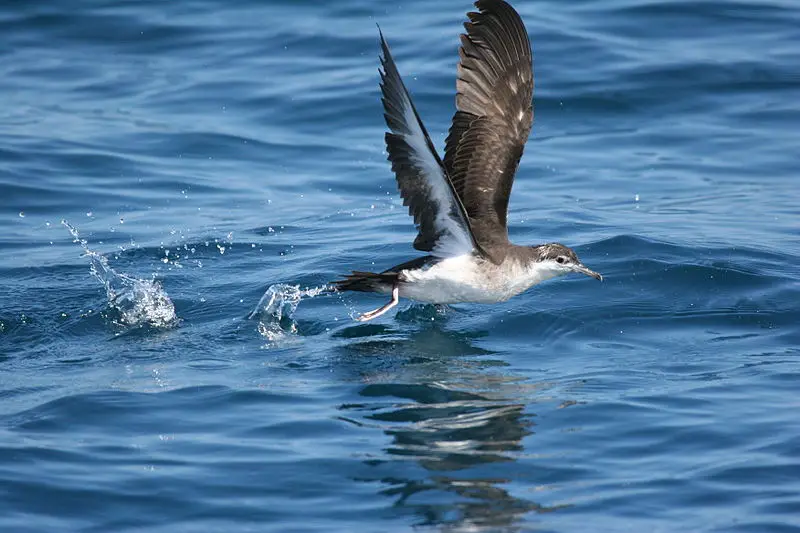
Audubon’s shearwater is a type of seabird belonging to the petrel family. It has many different monikers, including Baillon’s shearwater, tropical shearwater, Bannerman’s shearwater, Mascarene shearwater and Persian Sheawater.
This species was first discovered by French naturalist F�lix Louis L’Herminier in 1836 and earned its scientific name (Puffinus lherminieri) in his honour.
These birds are found throughout tropical oceans across the world from Africa to Asia and even Hawaii.
They have dark brown back feathers with white bellies which help them blend into their environment for protection against predators.
Audubon�s Sheerwaters feed on small fish near ocean surfaces or dive deep underwater when necessary due to their strong wings allowing them excellent swimming capabilities through powerful winds at sea level as well as incredible endurance during long distance flights over vast areas of open water around islands or coastlines.Scientific classification:
| Kingdom | Animalia |
| Phylum | Chordata |
| Class | Aves |
| Order | Procellariiformes |
| Family | Procellariidae |
| Genus | Puffinus |
| Species | P. lherminieri |
Also Featured In: Bahamas Birds,
30. Pearly-Eyed Thrasher
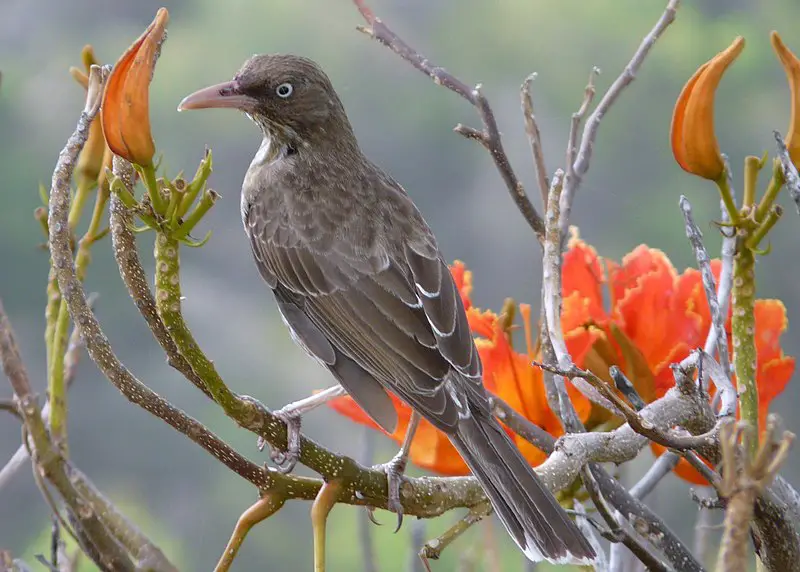
The Pearly-eyed Thrush is a unique and beautiful bird native to the Caribbean islands. It has stunning pearly eyes, with white patches on its wings and tail.
This thrasher measures up to 28-30 cm in length, making it the largest species of Mimidae family found in this area.
With an isolated subspecies living on Bonaire island, these birds have adapted well to their environment over time.
They feed mainly on insects found around them, but will also eat fruits or berries when available for extra nourishment.
These birds are often seen singing together as part of group displays at dawn or dusk – one more reason why they are so special.Scientific classification:
| Kingdom | Animalia |
| Phylum | Chordata |
| Class | Aves |
| Order | Passeriformes |
| Family | Mimidae |
| Genus | Margarops P.L. Sclater, 1859 |
| Species | M. fuscatus |
Also Featured In: Winged Marvels of St Martin’s: A Bird Enthusiast’s Delight,
31. Scaly-Naped Pigeon
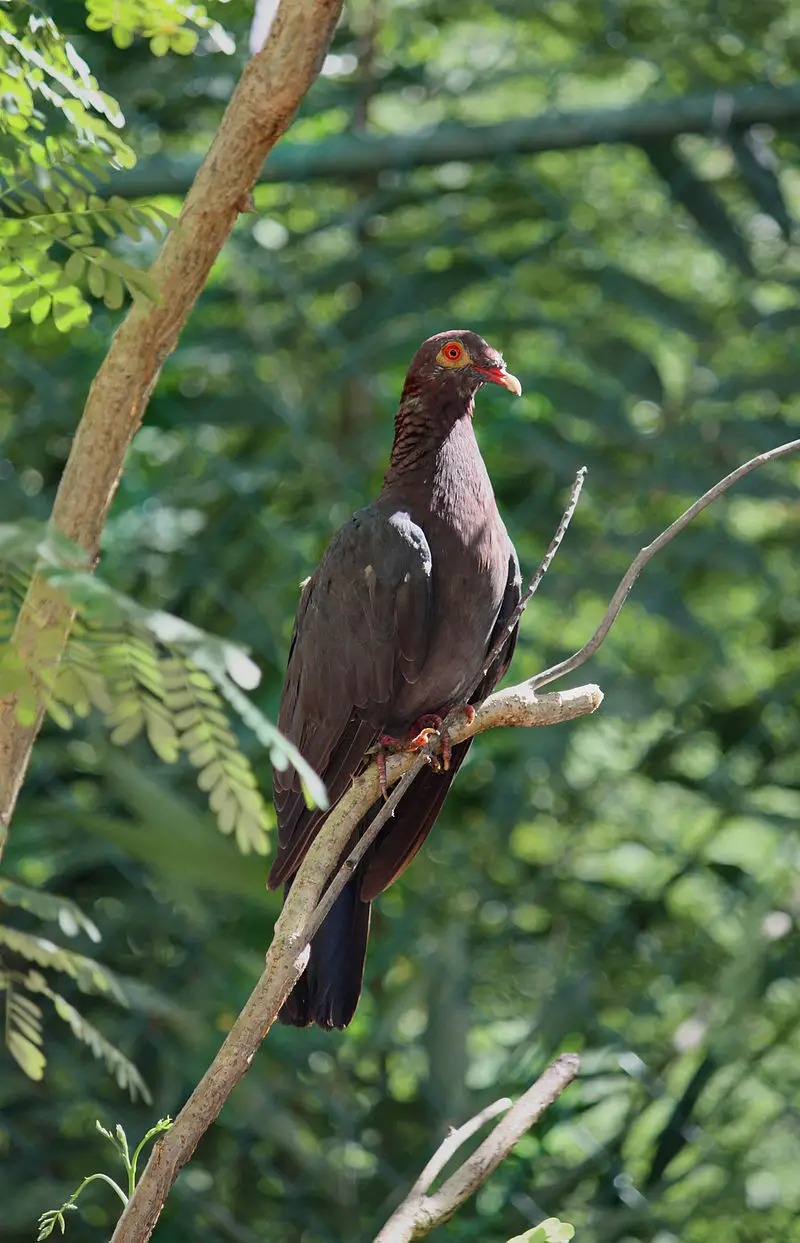
The scaly-naped pigeon is a large bird belonging to the family Columbidae. It has slate grey plumage with maroon coloured feathers around its neck, giving it the common name of red-necked pigeon.
The species originates from throughout the Caribbean and can reach 14–16 inches in length.
Its scientific name is derived from its unique feature: small scales on its nape which form an attractive pattern when viewed up close.
This makes them easily distinguishable from other birds within their range as they are one of few that have this characteristic.
They feed mainly on fruit but also consume seeds, insects and even carrion depending on availability at any given time of year or location.Scientific classification:
| Kingdom | Animalia |
| Phylum | Chordata |
| Class | Aves |
| Order | Columbiformes |
| Family | Columbidae |
| Genus | Patagioenas |
| Species | P. squamosa |
Also Featured In: Common Birds of St. Vincent Island, Common Birds Found near Necker Island
32. Green-Throated Carib
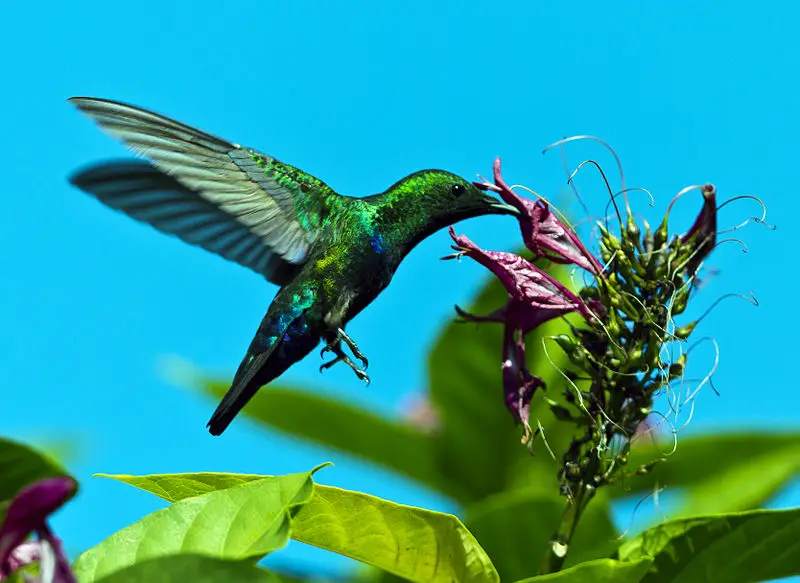
The Green-throated Carib is a species of hummingbird found in Puerto Rico and most of the Lesser Antilles. It was described by Swedish naturalist Carl Linnaeus in 1758.
The bird has distinctive green throat feathers, with iridescent blue on its back and wings. Its tail feathers are blackish brown at the base and white towards the tip, forming two distinct bands across their length.
This beautiful creature usually feeds on nectar from flowers or small insects such as spiders, bees and ants that it catches while flying through foliage.
Despite being fairly common throughout its range, this delightful little bird faces some threats due to habitat loss caused by human activity like agriculture or development projects taking place in areas where they live naturally.Scientific classification:
| Kingdom | Animalia |
| Phylum | Chordata |
| Class | Aves |
| Order | Apodiformes |
| Family | Trochilidae |
| Genus | Eulampis |
| Species | E. holosericeus |
Also Featured In: Barbados Birds,
33. Gray Kingbird
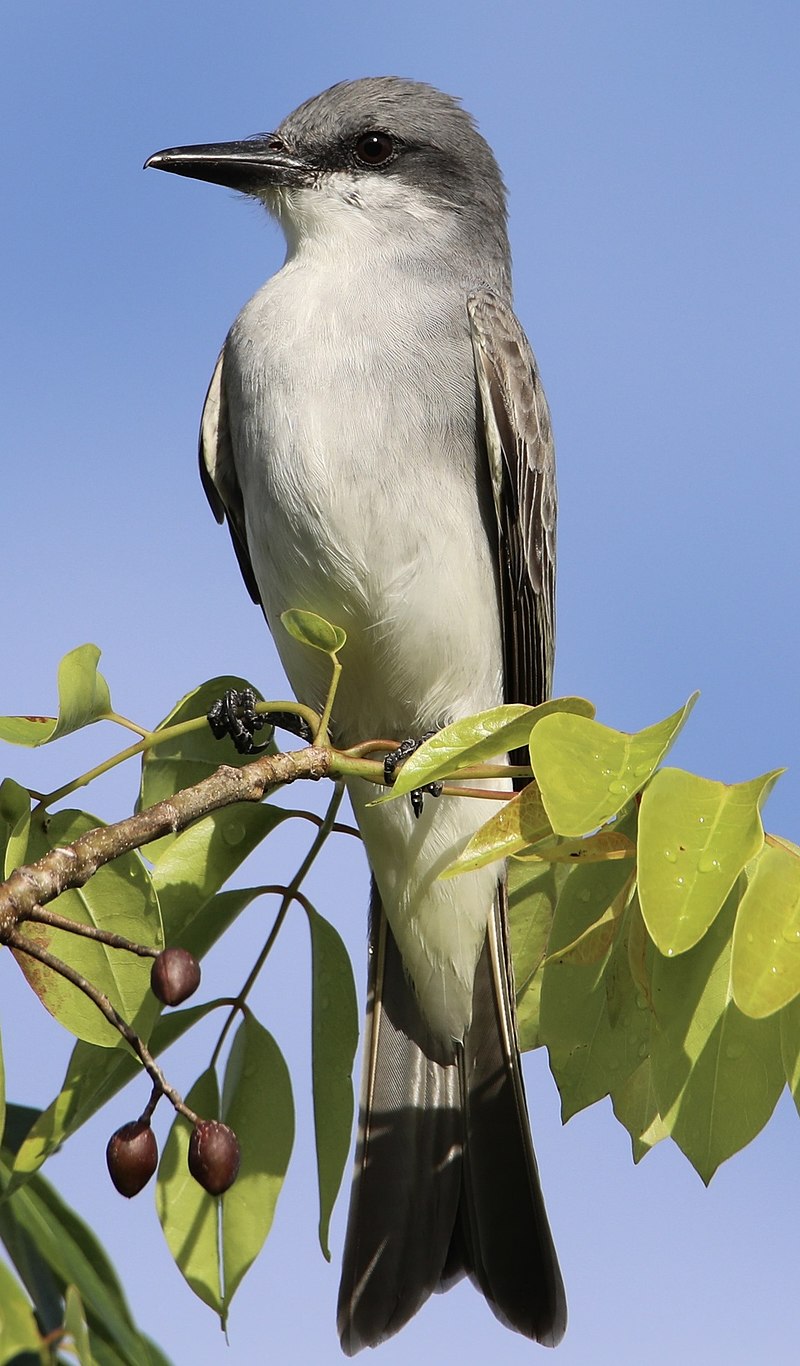
The Gray Kingbird is a species of tyrant flycatcher found in tall trees and shrubs, including the edges of savannas and marshes. It has gray feathers on its back with white underparts and blackish wings.
Its head is dark gray-brown or olive, while its tail is tipped with white. The Gray Kingbird builds flimsy cup nests from twigs in tree branches for their eggs to incubate safely until they hatch into chicks.
They feed mainly on insects such as moths, grasshoppers, beetles, crickets and caterpillars that can be caught midair when it swoops down from above like other kingbirds do.
This bird’s call consists of loud chirps which are often heard during mating season – making them an easily identifiable species within areas where they live.Scientific classification:
| Kingdom | Animalia |
| Phylum | Chordata |
| Class | Aves |
| Order | Passeriformes |
| Family | Tyrannidae |
| Genus | Tyrannus |
| Species | T. dominicensis |
Also Featured In: Birds That Live In Boca Grande, Most Common Birds of Caladesi Island
34. Carib Grackle
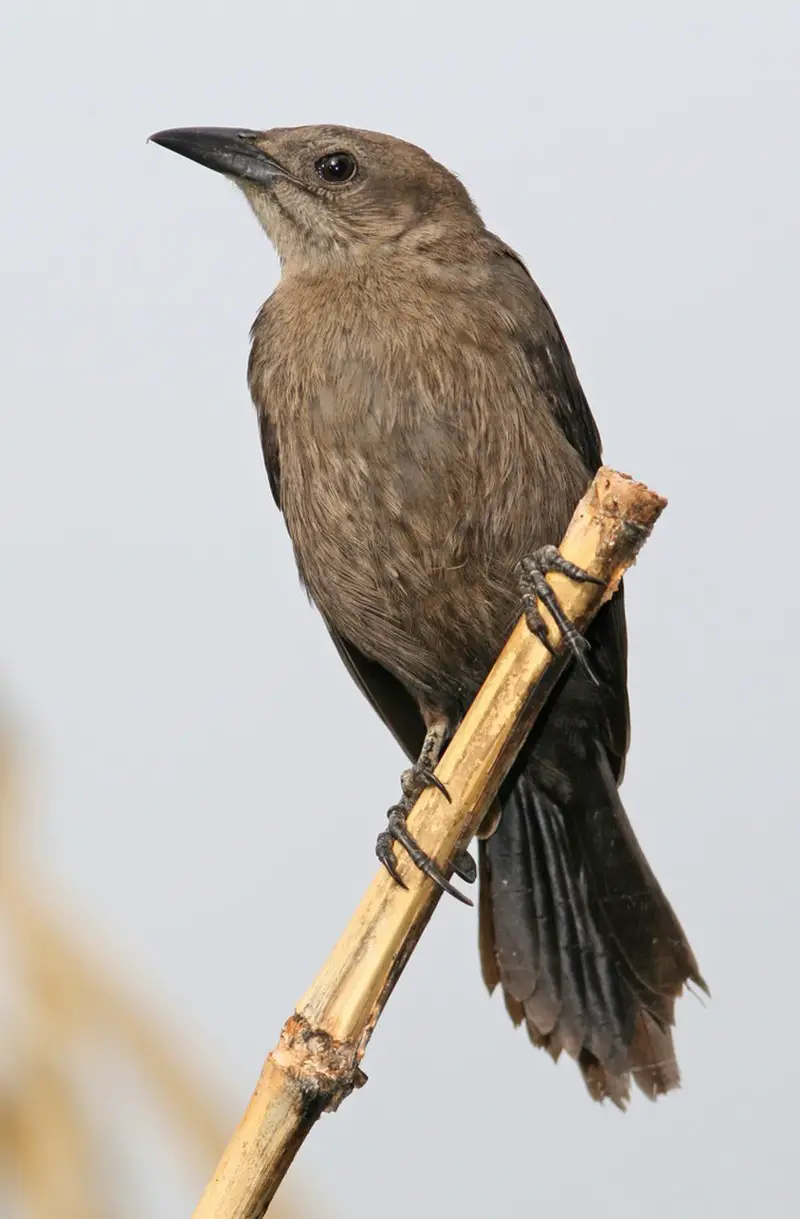
The Carib grackle is a tropical blackbird found in the Lesser Antilles and northern South America. It has eight subspecies, with the most widespread being Q. l. lugubris which can be found on Trinidad and much of mainland South America.
This particular subspecies was introduced to Puerto Rico during the 19th century where it now thrives due to its adaptability and tolerance towards human activity such as living near grazing animals or around farms.
Its diet consists mainly of small invertebrates, fruits, seeds and grains – all readily available in populated areas making it ideal for urban environments too.
They are also known for their beautiful songs used by males during breeding season to attract females but unfortunately this doesn’t last long as they generally only mate once throughout life before moving onto find another partner shortly after nesting season ends.Scientific classification:
| Kingdom | Animalia |
| Phylum | Chordata |
| Class | Aves |
| Order | Passeriformes |
| Family | Icteridae |
| Genus | Quiscalus |
| Species | Q. lugubris |
35. Zenaida Dove
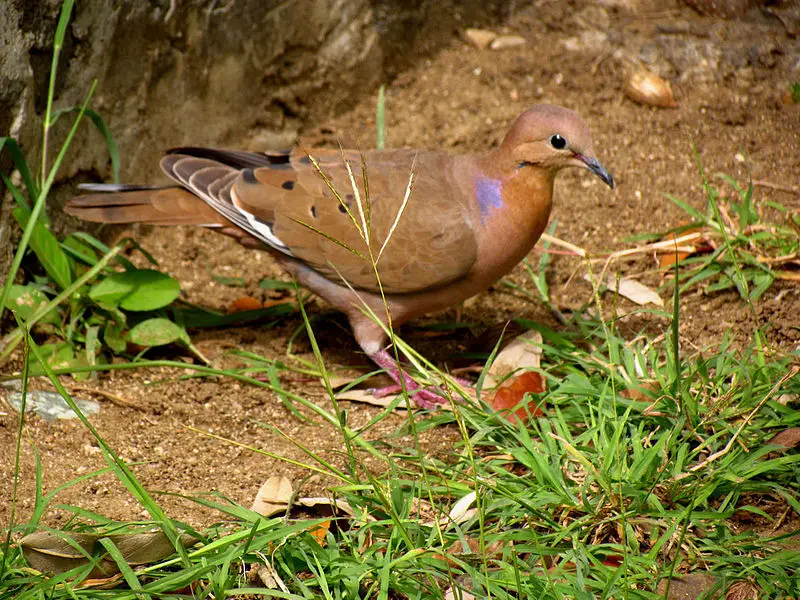
The Zenaida dove is a species of doves and pigeons found mainly in the Caribbean, but also parts of Mexico, Central America and South America.
With its distinct dark coloring, short rounded tail and an average length of 28-30 cm (11-12 inches), it stands out from other bird families.
It’s recognized as the national bird for Anguilla where locals refer to it as ‘turtle dove’. They are seen flying around open grasslands or roosting on tree branches close by populated areas.
These birds feed mostly on seeds that they pick off the ground while walking through fields.
The Zenaida Dove breeds all year round producing two broods during spring and summer months with both male and female taking turns incubating eggs over a span of 14 days before hatching into chicks.Scientific classification:
| Kingdom | Animalia |
| Phylum | Chordata |
| Class | Aves |
| Order | Columbiformes |
| Family | Columbidae |
| Genus | Zenaida |
| Species | Z. aurita |
Also Featured In: Great Abaco Island Birds,
36. Caribbean Elaenia
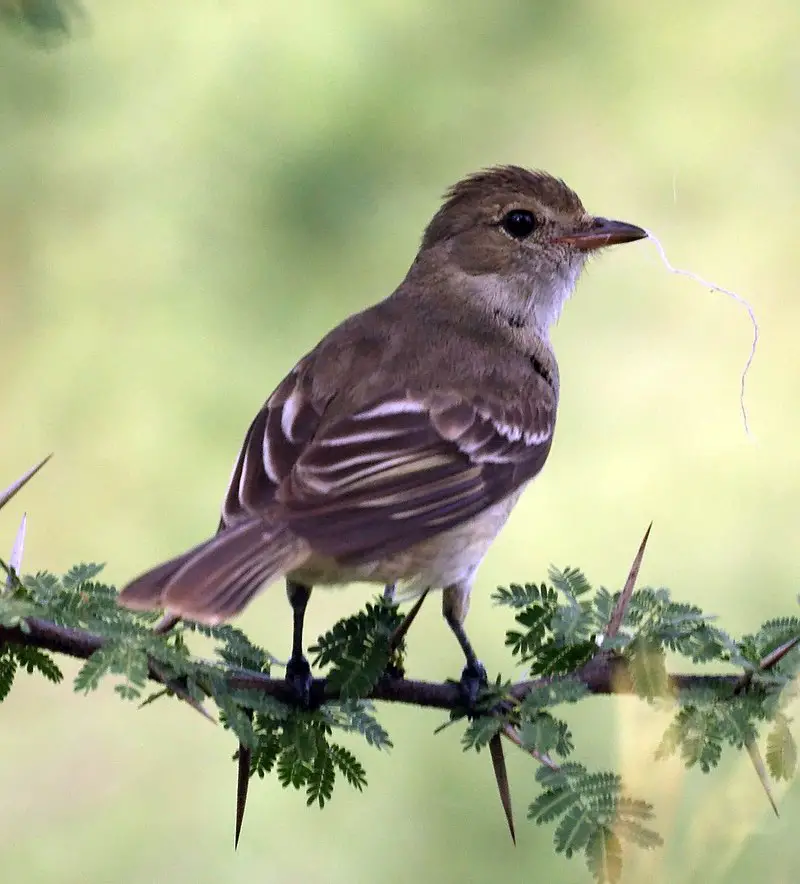
The Caribbean elaenia is a species of small bird that can be found in the West Indies and parts of Central America.
It is part of the Tyrannidae family and inhabits tropical dry broadleaf forests, subtropical or tropical moist lowland forests, as well as heavily degraded former forest areas.
In 1760, French zoologist Mathurin Jacques Brisson provided an extensive description on this species which has helped us gain further knowledge about it today.
The Caribbean elaenia typically measures around 6-9 inches long with predominantly olive green feathers with yellowish edges to some wings and tails.
They have white throats but lack any distinctive markings on their chest unlike many other birds from its family.
This bird feeds primarily on insects such as grasshoppers collected from trees or bushes while also consuming fruit when available during certain times of year.Scientific classification:
| Kingdom | Animalia |
| Phylum | Chordata |
| Class | Aves |
| Order | Passeriformes |
| Family | Tyrannidae |
| Genus | Elaenia |
| Species | E. martinica |
37. Common Ground Dove
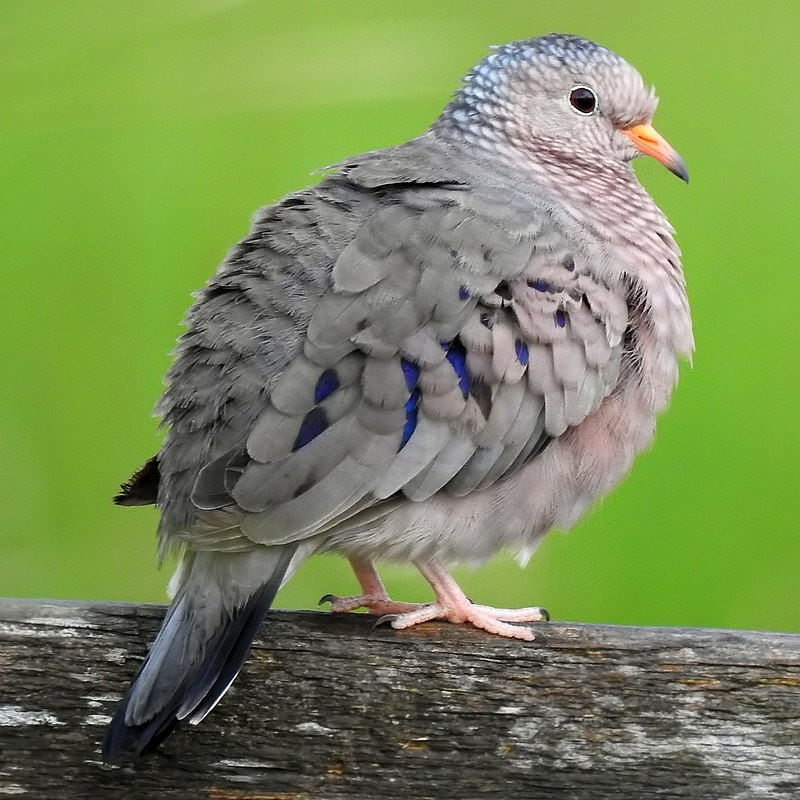
The Common Ground Dove is a small bird that can be found in the southern United States, Central America, the Caribbean and northern South America.
It’s considered to be one of the smallest dove species in North American with an average length of around 6–7 inches.
This ground-dwelling species spends most of its time on foot but has been known to fly when necessary or threatened.
The plumage is pale grayish brown above while their bellies are white and speckled with black spots along their wings.
Its diet consists mainly of seeds from grasses and other low vegetation which it forages for by walking slowly across open fields or lawns looking for food items like berries, grains, insects, spiders and snails.Scientific classification:
| Kingdom | Animalia |
| Phylum | Chordata |
| Class | Aves |
| Order | Columbiformes |
| Family | Columbidae |
| Genus | Columbina |
| Species | C. passerina |
Also Featured In: Birds You’ll Find in the Rio Grande Valley, Native Birds in Lower Rio Grande Valley
38. Lesser Antillean Pewee
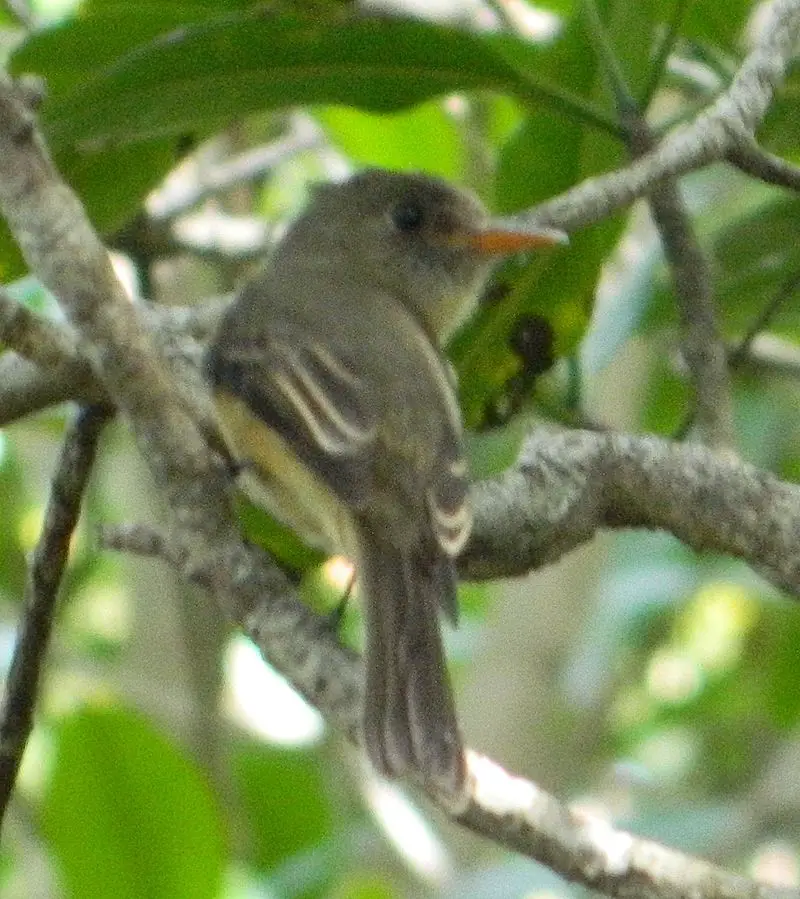
The Lesser Antillean pewee is a species of bird found in the family Tyrannidae. It can be spotted in Dominica, Guadeloupe, Martinique, Puerto Rico and Saint Lucia with records from Saint Kitts.
In fact some experts suggest that birds on Puerto Rico are different enough to be considered their own species (Puerto Rican pewee) while those living on St Lucia are also distinct enough to have been named ‘St Lucian Pewees’.
This small songbird prefers habitats like tropical or subtropical moist lowland forests as well as heavily degraded former forest areas.
With its drab grayish-brown plumage it’s rather unassuming but during breeding season males will give a distinctive “churrr” call which makes them easier to spot.Scientific classification:
| Kingdom | Animalia |
| Phylum | Chordata |
| Class | Aves |
| Order | Passeriformes |
| Family | Tyrannidae |
| Genus | Contopus |
| Species | C. latirostris |
Also Featured In: Saint Lucia Birds,
39. Purple-Throated Carib
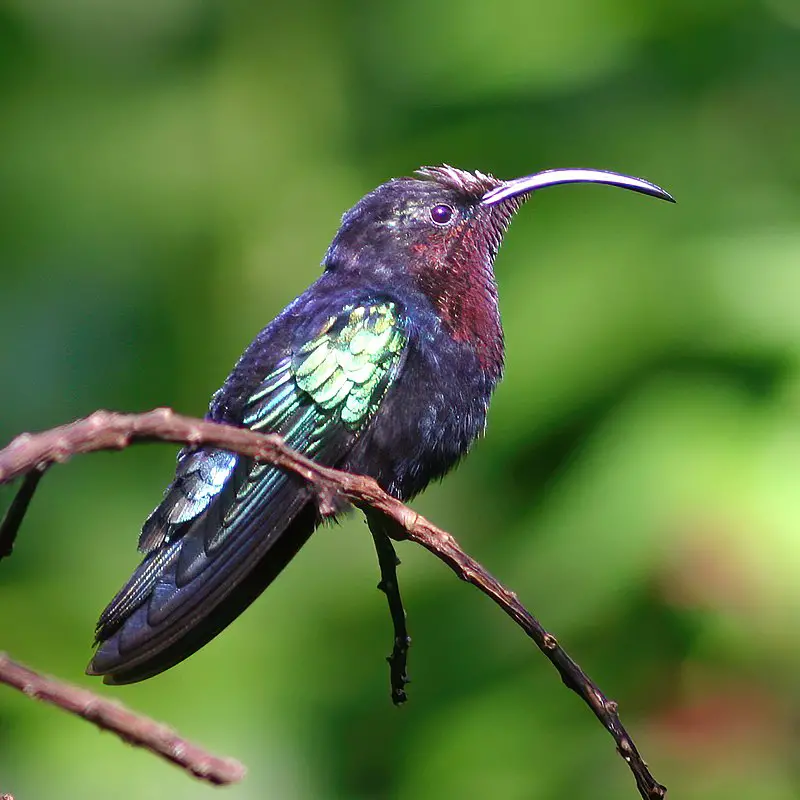
The Purple-throated Carib is a species of hummingbird found in the Lesser Antilles islands. It has stunning purple feathers along its throat, making it quite easy to identify amongst other birds.
This bird is usually seen alone or in pairs and can be found near forests and gardens where they feed on nectar from flowers.
The Purple-throated Carib also feeds on insects which helps keep insect populations under control around their habitat areas.
They are known as strong fliers that have been spotted both north and south of the Caribbean Islands showing just how far this resilient species can travel.
Overall, this vibrant little bird adds beautiful colour to any garden with its mesmerising plumage while providing an essential service at controlling bug numbers too.Scientific classification:
| Kingdom | Animalia |
| Phylum | Chordata |
| Class | Aves |
| Order | Apodiformes |
| Family | Trochilidae |
| Genus | Eulampis |
| Species | E. jugularis |
40. Lesser Antillean Flycatcher
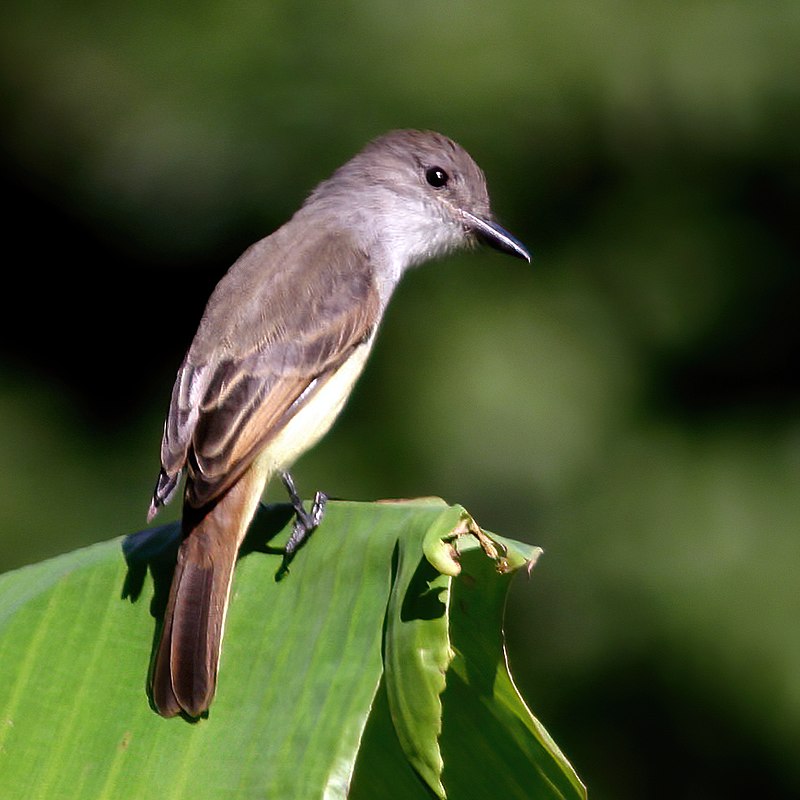
The Lesser Antillean flycatcher is a species of bird found in the Caribbean region. It belongs to the family Tyrannidae and inhabits subtropical or tropical moist lowland forests.
This small songbird has long wings, rounded heads, and short bills with distinct dark markings on its upperparts. Its diet consists mostly of insects which it catches by flying around branches and foliage looking for prey.
The Lesser Antillean flycatcher also builds its nest near tree trunks using twigs, leaves, feathers, grasses and bark strips as materials for construction.
Despite being widely distributed across several islands in the Caribbean Sea this species is considered vulnerable due largely to habitat destruction caused by human activities such as logging and urbanization throughout their range area.Scientific classification:
| Kingdom | Animalia |
| Phylum | Chordata |
| Class | Aves |
| Order | Passeriformes |
| Family | Tyrannidae |
| Genus | Myiarchus |
| Species | M. oberi |
41. Bridled Quail-Dove
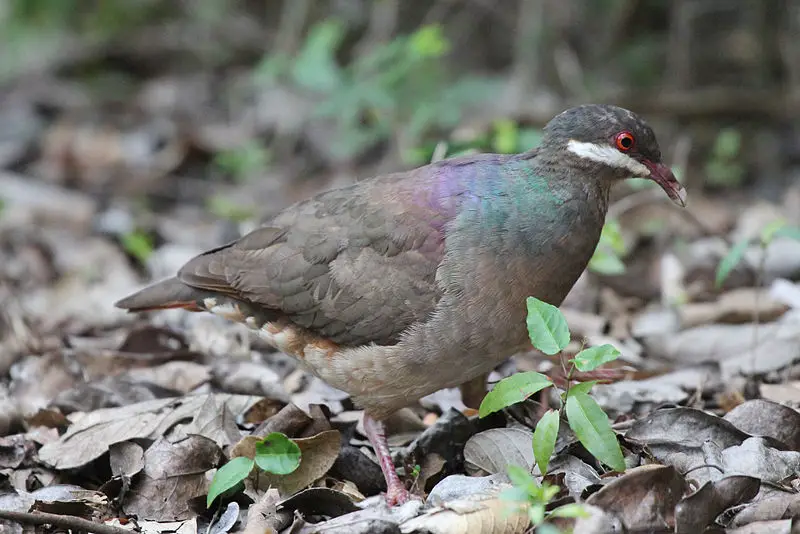
The Bridled Quail-Dove is a species of bird in the Columbidae family, found from Saint Lucia to Puerto Rico. It is monotypic, and it has been suggested that it forms a superspecies with Key West Quail-Doves.
Its mean weight varies between islands; generally being quite small at 93–128 g (3.3–4.5 oz).
They have distinctly barred heads and greyish white underparts with some dark barring on their backs, wings and tails – giving them an overall ‘bridled’ look for which they are named after.
In addition to this striking appearance they make deep cooing sounds whilst perched or hunting for food on the ground – particularly during breeding season when males compete against each other by singing different variations of their call simultaneously.Scientific classification:
| Kingdom | Animalia |
| Phylum | Chordata |
| Class | Aves |
| Order | Columbiformes |
| Family | Columbidae |
| Genus | Geotrygon |
| Species | G. mystacea |
42. Scaly-Breasted Thrasher
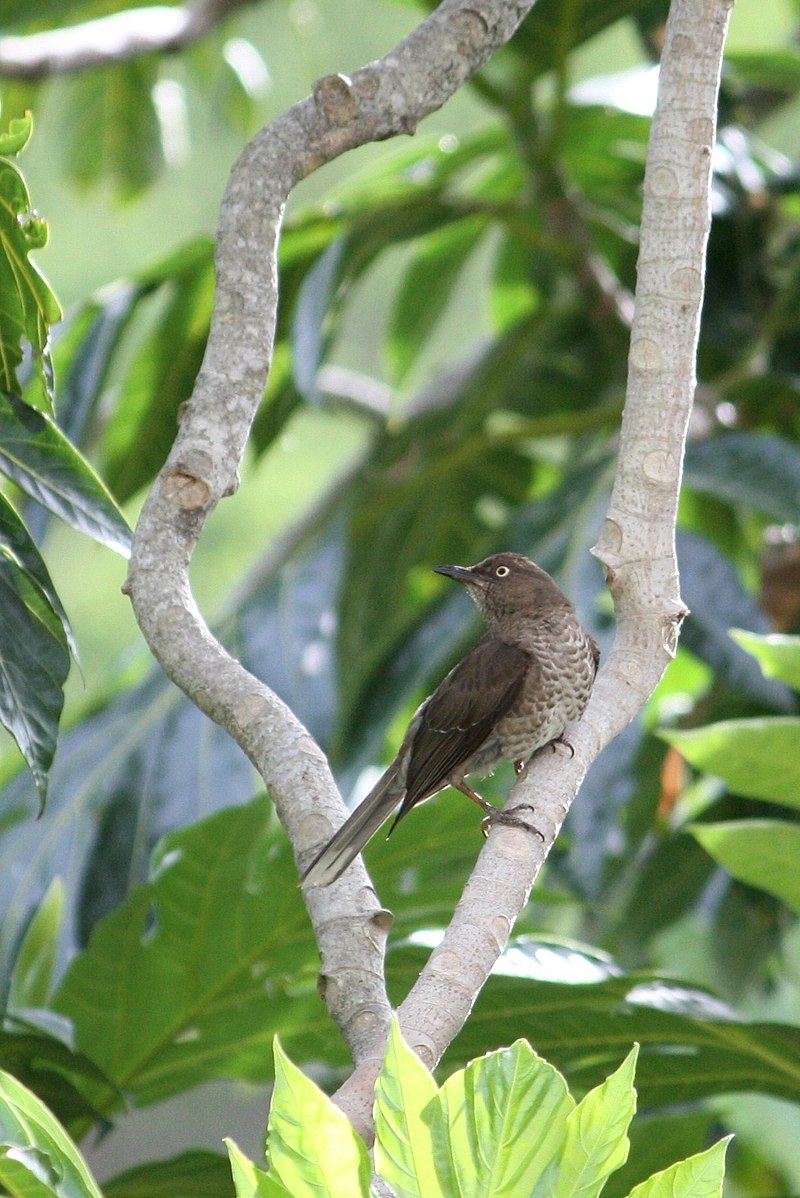
The Scaly-breasted Thrasher is a species of bird in the family Mimidae, found throughout much of the Lesser Antilles.
It has five subspecies and is approximately 23 cm long with greyish brown upperparts and black wings marked with white spots.
Its underparts are reddish orange to yellow buff, finely scaled or scalloped with darker edges, giving it its name.
This thrasher feeds mainly on insects but also eats fruits and berries as well as small lizards.
The male performs elaborate courtship displays which include soaring flights high into the air followed by singing from perches at the tops of trees or shrubs during breeding season between February – May period each year .
It typically nests low down in thickets near water sources such as rivers or streams using twigs bound together with spider web silk for nesting material , laying 2 to 3 eggs at one time.
The Scaly-breasted Thrashers are overall common birds that inhabit various habitats including mangroves, rainforests and dry scrublands across their range making them an important part of local ecosystems within their range.Scientific classification:
| Kingdom | Animalia |
| Phylum | Chordata |
| Class | Aves |
| Order | Passeriformes |
| Family | Mimidae |
| Genus | Allenia Cory, 1891 |
| Species | A. fusca |
Also Featured In: Common Birds Found near Montserrat,
43. Caribbean Martin
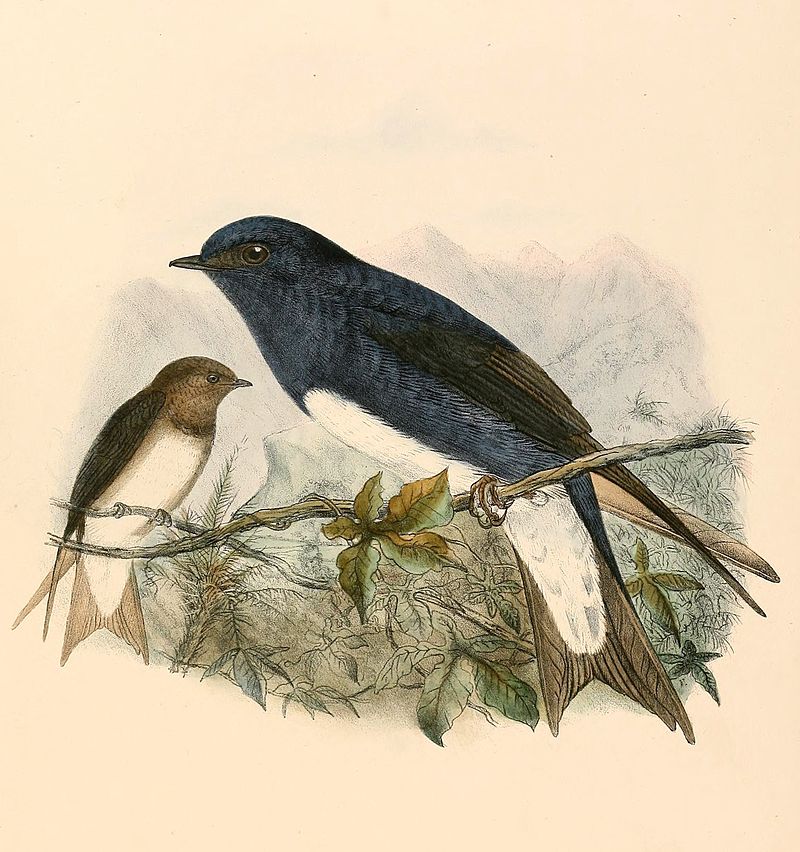
The Caribbean martin is a large swallow that can be found throughout the Caribbean, except on Cuba and Isla de la Juventud.
It has at various times been thought to be related to the purple martin but more recently it has been recognised as its own species – Progne dominicensis.
This species is closely related to both the Cuban martin (P. cryptoleuca) and South American martins (S. chirica).
The adult birds have predominantly white underparts with grey-brown upper parts and black wings.
Their tail feathers are forked in shape making them very distinctive when flying through their habitats of open woodlands, savannas or mangroves near bodies of water such as lakes or rivers where they feed mainly on insects like dragonflies or termites.Scientific classification:
| Kingdom | Animalia |
| Phylum | Chordata |
| Class | Aves |
| Order | Passeriformes |
| Family | Hirundinidae |
| Genus | Progne |
| Species | P. dominicensis |
44. Common Gallinule
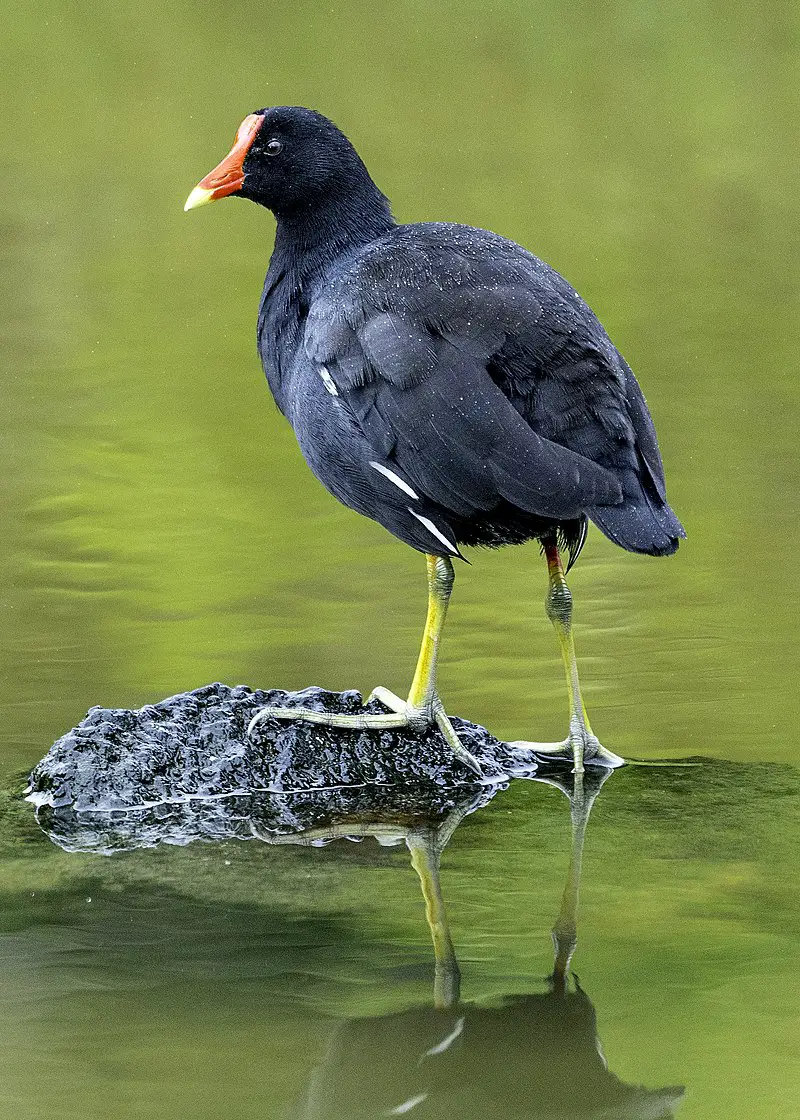
The Common Gallinule is a bird of the Rallidae family, native to parts of the Americas. It can be found in marshes, ponds and other wetland habitats which are well-vegetated.
This species prefers temperate climates and is not generally seen in polar regions or rainforests.
It has mainly greyish plumage with black wings and tail feathers, while its head has orange markings on either side along with an orange bill and yellow legs.
The underside usually appears white when flying but may have buffy undertones during breeding season.
Its diet consists primarily of aquatic vegetation as well as small invertebrates such as insects, snails or tadpoles; sometimes it will also take grains from fields nearby wetlands if available.
The Common Gallinule’s main call is a loud “kuk-kaa-kow” sound that can often be heard echoing across these areas where they reside.Scientific classification:
| Kingdom | Animalia |
| Phylum | Chordata |
| Class | Aves |
| Order | Gruiformes |
| Family | Rallidae |
| Genus | Gallinula |
| Species | G. galeata |
Also Featured In: Bermuda birds, Long Island Birds You Should Know
45. Laughing Gull
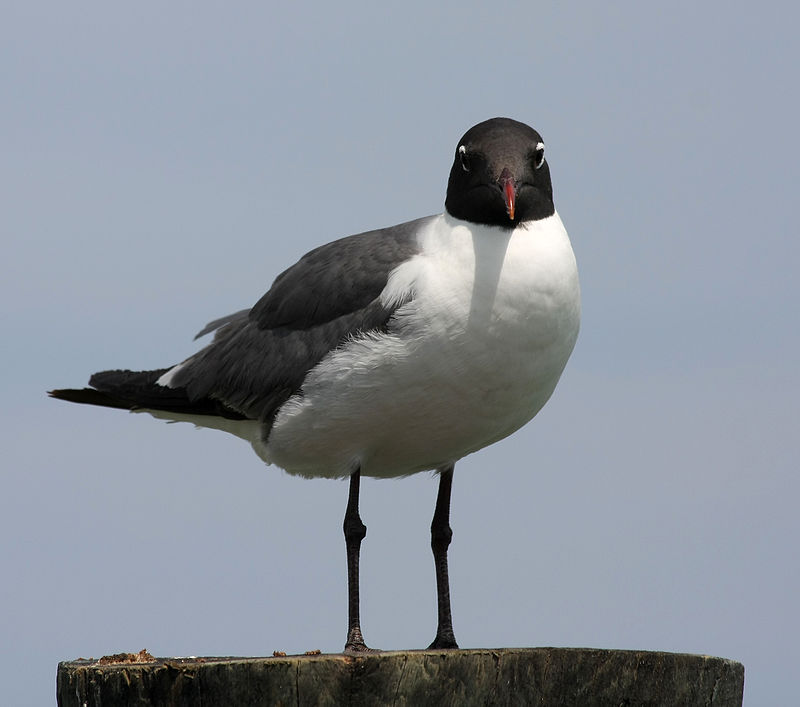
The Laughing Gull is a medium-sized bird with gray wings, black head and white underparts. It has bright red legs and bill which make it easily distinguishable from other gulls.
The name comes from its unique laughing call which can be heard in coastal areas throughout the Americas where they breed. They are opportunistic omnivores that feed on fish, carrion, insects or even garbage when available.
During breeding season these birds form large colonies along the Atlantic coast of North America as well as parts of northern South America and Caribbean islands.
There are two subspecies; L megalopturus found in Canada to Central America while L atricilla inhabits rest of their range..
These species have become more common inland due to human settlement near coasts creating ideal habitat for them but also making them scavengers around urban areas.Scientific classification:
| Kingdom | Animalia |
| Phylum | Chordata |
| Class | Aves |
| Order | Charadriiformes |
| Family | Laridae |
| Genus | Leucophaeus |
| Species | L. atricilla |
Also Featured In: Gulls Species, Birds You’ll Find in South Texas
46. American Purple Gallinule
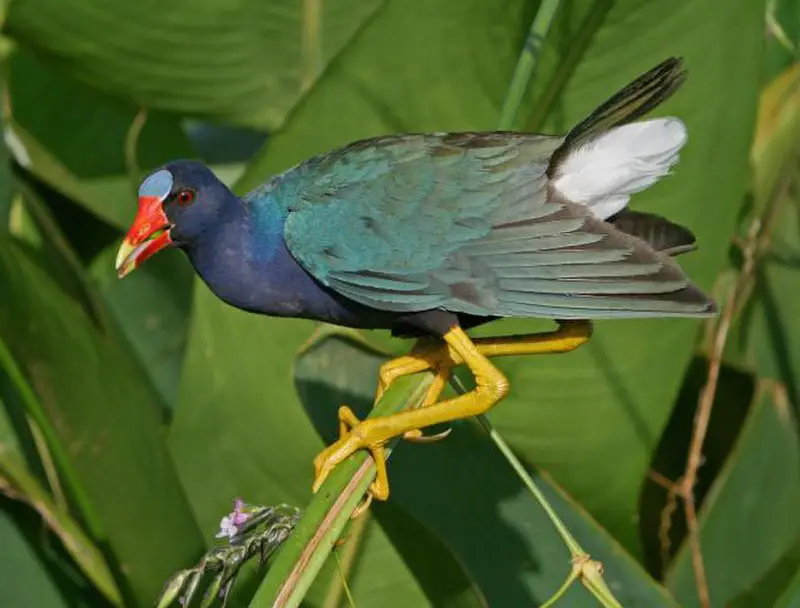
The American purple gallinule is a stunning bird found in North and South America. This species belongs to the order Gruiformes, which contains cranes, rails and crakes.
The family Rallidae classifies it as a rail species with its scientific name being Porphyrio martinica.
It is also known locally as the yellow-legged gallinule due to its striking plumage of greenish blue feathers on wings, back and tail along with bright red legs and bill.
Its environment includes freshwater marshes, swamps or paddy fields where these birds feed mostly on plants like water lilies or small invertebrates such as insects or molluscs.
These beautiful creatures are threatened by habitat destruction especially for agricultural purposes but conservation efforts are helping them survive despite this threat.Scientific classification:
| Kingdom | Animalia |
| Phylum | Chordata |
| Class | Aves |
| Order | Gruiformes |
| Family | Rallidae |
| Genus | Porphyrio |
| Species | P. martinicus |
Also Featured In: Florida Birds, Blue Birds You’ll Found around Us
47. Kentucky Warbler
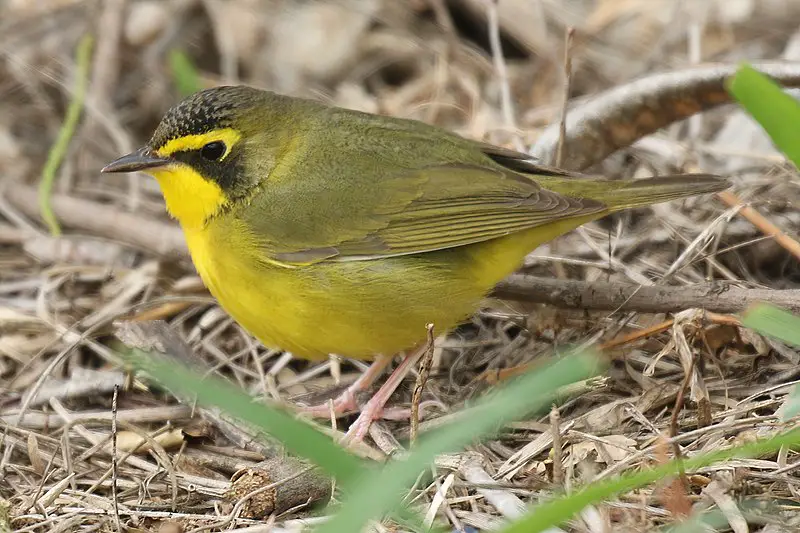
The Kentucky Warbler is a beautiful bird, with its olive-green back and brilliant yellow underside.
Its short tail and sluggish behavior make it distinct from other warblers, as they prefer to stay on or near the ground rather than fly around like others of their species.
These birds are native to North America and can be seen in deciduous woodlands during summer months searching for insects among leaf litter.
They have a small hint of black at their throats which stands out against their vibrant coloring making them stand out even more.
During breeding season males sing loudly from high perches in order to court females who will then build nests hidden away close by the ground nearby sources of water such as streams or ponds where food supplies are plentiful for raising young chicks.Scientific classification:
| Kingdom | Animalia |
| Phylum | Chordata |
| Class | Aves |
| Order | Passeriformes |
| Family | Parulidae |
| Genus | Geothlypis |
| Species | G. formosa |
Also Featured In: birds of Kentucky, Birds in Iowa Spring
48. Brown Pelican

The majestic brown pelican is a dive-feeding bird that belongs to the pelican family. It is one of the three pelican species found in the Americas and is known to dive into water to catch its prey.
From the Atlantic Coast of New Jersey to the mouth of the Amazon River, and along the Pacific Coast from British Columbia to northern Chile, including the Galapagos Islands, this bird can be found.
Its scientific name is Pelecanus occidentalis, and it has a colored brown plumage, which is its distinct characteristic.
The brown pelican belongs to the largest bird species that exist today, with a wingspan that can stretch up to seven feet long.
This bird helps maintain a balance in the ecosystem by eating smaller fish, crustaceans, and other aquatic prey.Scientific classification:
| Kingdom | Animalia |
| Phylum | Chordata |
| Class | Aves |
| Order | Pelecaniformes |
| Family | Pelecanidae |
| Genus | Pelecanus |
| Species | P. occidentalis |
Also Featured In: Birds You’ll Find in the Sea, Water Birds Live around Us
49. Solitary Sandpiper
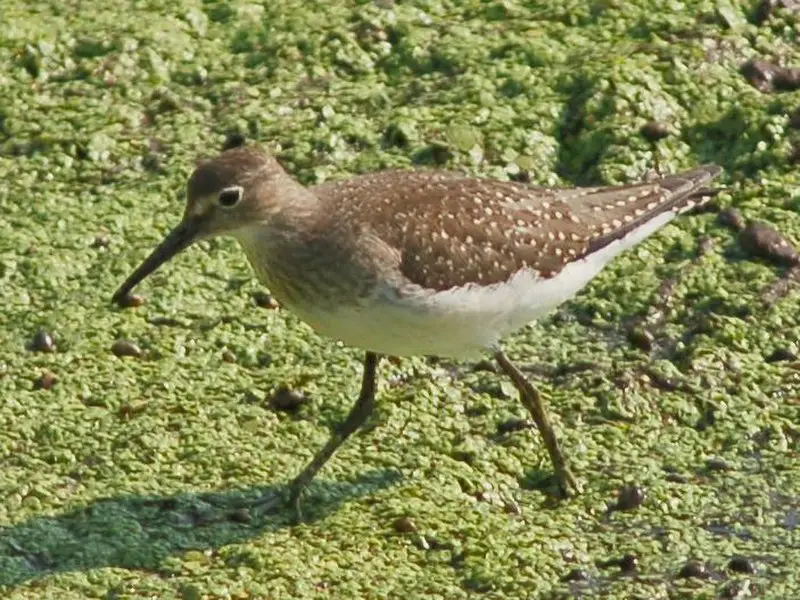
The Solitary sandpiper is a small shorebird that belongs to the Tringa genus. Its scientific name is Tringa solitaria, which means “solitary” in Latin. It measures 18-23 cm in length and has a distinct white-rumped tail.
The name Tringa comes from Ancient Greek trungas, which refers to a thrush-sized wading bird.
The Solitary sandpiper is named so because it is often found alone. It is a migratory bird that breeds in North America and winters in South America.
Its diet consists of insects, crustaceans, and small fish, which it picks up using its long, thin bill. Despite its name, this bird is not entirely solitary and has been known to feed and roost with other shorebirds.
The Solitary sandpiper is a unique and fascinating species that can be found in wetland habitats across North and South America.Scientific classification:
| Kingdom | Animalia |
| Phylum | Chordata |
| Class | Aves |
| Order | Charadriiformes |
| Family | Scolopacidae |
| Genus | Tringa |
| Species | T. solitaria |
Also Featured In: Common Central Park Birds, Birds that Migrate through Illinois in the Spring
50. Least Sandpiper
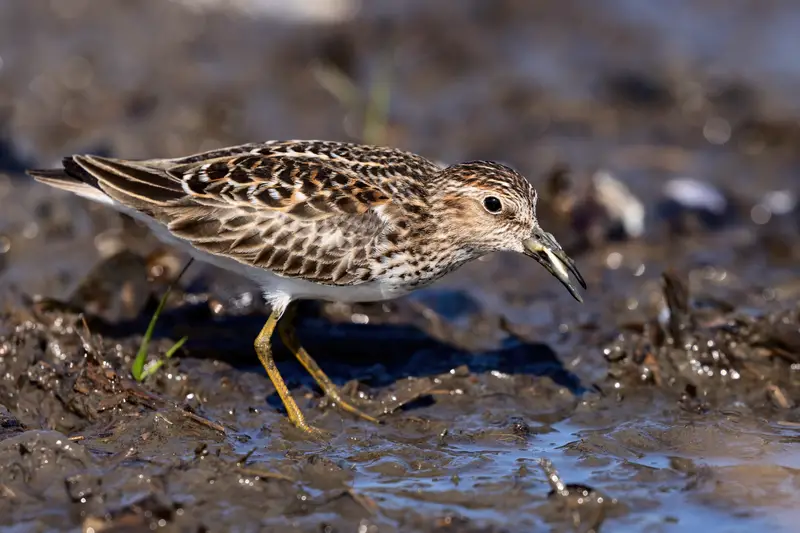
The Least Sandpiper is a shorebird that holds the title for being the smallest of its kind. Its Ancient Greek genus name, kalidris or skalidris, referred to grey-colored waterside birds.
The breed’s brown feathers with dark brown streaks, white underside, greenish legs, and short, thin, dark bill characterize adult Least Sandpipers.
The Medieval Latin name of the species, minutilla, further describes the breed’s tiny size.
These birds are known to inhabit shallow water marshes and mudflats during the summertime, and they migrate to coasts during the winters.
Least Sandpipers mainly feed on insects and small crustaceans, often by running and pecking in shallow water or mud.
Despite their small size, these birds travel great distances during migration, making impressive journeys from their breeding and wintering grounds.Scientific classification:
| Kingdom | Animalia |
| Phylum | Chordata |
| Class | Aves |
| Order | Charadriiformes |
| Family | Scolopacidae |
| Genus | Calidris |
| Species | C. minutilla |
Also Featured In: Most Common Lake Birds, Birds in Pacific Northwest
51. Wilson’s Snipe
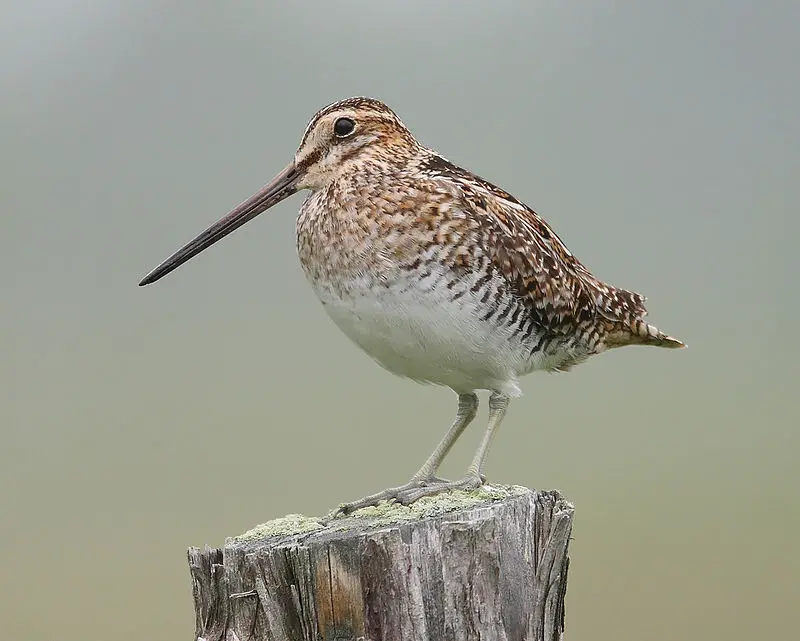
Wilson’s snipe is a small shorebird characterized by its stocky physique. Its genus name, gallinago, refers to it being a woodcock or snipe, while its specific name, delicata, means “dainty” in Latin.
This bird used to be a subspecies of the common snipe until 2003, when it was recognized as a distinct species.
Despite its small size, the Wilson’s snipe is highly capable in flight and has been known to fly thousands of miles during migration.
Its distinctive bill, which is long and straight, is used primarily for probing in the mud for food. Although it is primarily found in wetlands and marshes, this bird may also venture into other habitats during breeding season.
The Wilson’s snipe has a unique mating call, which sounds like a winnowing or bleating sound, and can often be heard during early mornings and late evenings in their breeding territories.Scientific classification:
| Kingdom | Animalia |
| Phylum | Chordata |
| Class | Aves |
| Order | Charadriiformes |
| Family | Scolopacidae |
| Genus | Gallinago |
| Species | G. delicata |
Also Featured In: Birds that Found in the Yellowstone , Native Birds Of West Swan Island